- Website Inauguration Function.
- Vocational Placement Cell Inauguration
- Media Coverage.
- Certificate & Recommendations
- Privacy Policy
- Science Project Metric
- Social Studies 8 Class
- Computer Fundamentals
- Introduction to C++
- Programming Methodology
- Programming in C++
- Data structures
- Boolean Algebra
- Object Oriented Concepts
- Database Management Systems
- Open Source Software
- Operating System
- PHP Tutorials
- Earth Science
- Physical Science
- Sets & Functions
- Coordinate Geometry
- Mathematical Reasoning
- Statics and Probability
- Accountancy
- Business Studies
- Political Science
- English (Sr. Secondary)

Hindi (Sr. Secondary)
- Punjab (Sr. Secondary)
- Accountancy and Auditing
- Air Conditioning and Refrigeration Technology
- Automobile Technology
- Electrical Technology
- Electronics Technology
- Hotel Management and Catering Technology
- IT Application
- Marketing and Salesmanship
- Office Secretaryship
- Stenography
- Hindi Essays
- English Essays
Letter Writing
- Shorthand Dictation
Essay on “Vedas” Complete Essay for Class 10, Class 12 and Graduation and other classes.
Vedas are the foremost sacred books of Hinduism. There are four Vedas and they claim to teach a man the highest truths that can lead him to God. The first three vedas are known as the Triple vedas.
The Rig veda (veda of Hymns) consists of 1028 hymns (ten books) to gods like Indra and Agni.
The Yajur veda (veda of liturgy) concerns the knowledge of rites. This veda is based on the fig veda. It contains the rules explaining how to perform all rituals. It consists of prose and verse. This veda is indeed a priestly handbook, even describing the rules and regulations of how to make an altar. Sacrifice is one of the most important parts of this veda.
The vast majority of Vedic hymns are addressed to a pantheon of deities who are attracted, generated, and nourished by the offerings into the sacred flames and the precisely chanted mantras (mystical formulas of invocation) based on the hymns. Each of these deities may appear to be the supreme god in his or her own hymns, but some gods stand out as most significant. Indra, god of the firmament and lord of the weather, is the supreme deity of the Vedas. Indra also is a god of war who, accompanied by a host of storm gods, uses thunderbolts as weapons to slay the serpent demon Vritra (the name means storm cloud), thus releasing the rains for the earth. Agni, the god of fire, accepts the sacrificial offerings and transmits them to all the gods. Varuna passes judgment, lays down the law, and protects the cosmic order. Yama, the god of death, sends earthly dwellers signs of old age, sickness, and approaching mortality as exhortations to lead a moral life. Surya is the sun god, Chandra the moon god, Vayu the wind god, and Usha the dawn goddess.
Some of the later hymns of the Rig Veda contain speculations that form the basis for much of Indian religious and philosophical thought. From one perspective, the universe originates through the evolution of an impersonal force manifested as male and female principles. Other hymns describe a personal creator, Prajapati, the Lord of creatures, from whom came the heavens and the earth and all the other gods. One hymn describes the universe as emerging from the sacrifice of a cosmic man (purusha) who was the source of all things but who was in turn offered into the fire by gods. Within the Vedic accounts of the origin of things, there is a tension between visions of the highest reality as an impersonal force, or as a creator god, or as a group of gods with different jobs to do in the universe. Much of Hinduism tends to accept all these visions simultaneously, claiming that they are all valid as different facets of a single truth, or ranks them as explanations with different levels of sophistication. It is possible, however, to follow only one of these explanations, such as believing in a single personal god while rejecting all others, and still claim to be following the Vedas. In sum, Hinduism does not exist as a single belief system with one textual explanation of the origin of the universe or the nature of God, and a wide range of philosophies and practices can trace their beginnings somewhere in the hymns of the Vedas.
By the sixth century BC., the Vedic gods were in decline among the people, and few people care much for Indra, Agni, or Varuna in contemporary India. These gods might appear as background characters in myths and stories about more important deities, such as Shiva or Vishnu; in some Hindu temples, Also there are small statues of Vedic deities. Sacrificial fire, which once accompanied major political activities, such as the crowning of kings or the conquest of territory, still forms the heart of household rituals for many Hindus, and some Brahman families pass down the skill of memorizing the hymns and make a living as professional reciters of the Vedas. One of the main legacies of Brahmanical sacrifice, seen even among traditions that later denied its usefulness, was a concentration on precise ritual actions and a belief in sacred sound as a powerful tool for manifesting the sacred in daily life.
About evirtualguru_ajaygour

Leave a Reply Cancel reply
Your email address will not be published. Required fields are marked *
Quick Links

Popular Tags
Visitors question & answer.
- Anska on Hindi Essay on “Parishram Saphalta ki Kunji Hai” , ”परिश्रम सफलता की कुंजी है ” Complete Hindi Essay for Class 10, Class 12 and Graduation and other classes.
- TEJAS on Hindi Essay on “Manoranjan Ke Adhunik Sadhan” , ” मनोरंजन के आधुनिक साधन” Complete Hindi Essay for Class 10, Class 12 and Graduation and other classes.
- Hania Shakeel on Hindi Essay on “Yadi mein Adhyapak Hota”, “यदि मैं अध्यापक होता” Complete Essay, Paragraph, Speech for Class 7, 8, 9, 10, 12 Students.
- Keshav on Hindi Essay on “Ekta me Shakti” , ”एकता में शक्ति” Complete Hindi Essay for Class 10, Class 12 and Graduation and other classes.
- Fucker on Short Story ”A Faithful Dog and its Master” Complete Story for Class 10, Class 12 and other classes.
Download Our Educational Android Apps

Latest Desk
- Samkaleen Bhartiya Mahilaye “समकालीन भारतीय महिलाएं” Hindi Essay, Nibandh 1000 Words for Class 10, 12 Students.
- Nijikarn – Gun evm Dosh “निजीकरण: गुण एवं दोष” Hindi Essay, Nibandh 1200 Words for Class 10, 12 Students.
- Bharat mein Mahilaon ke Rajnitik Adhikar “भारत में महिलाओं के राजनीतिक अधिकार” Hindi Essay, Nibandh 700 Words for Class 10, 12 Students.
- Bharat mein Jativad aur Chunavi Rajniti “भारत में जातिवाद और चुनावी राजनीति” Hindi Essay, Nibandh 1000 Words for Class 10, 12 Students.
- Example Letter regarding election victory.
- Example Letter regarding the award of a Ph.D.
- Example Letter regarding the birth of a child.
- Example Letter regarding going abroad.
- Letter regarding the publishing of a Novel.
Vocational Edu.
- English Shorthand Dictation “East and Dwellings” 80 and 100 wpm Legal Matters Dictation 500 Words with Outlines.
- English Shorthand Dictation “Haryana General Sales Tax Act” 80 and 100 wpm Legal Matters Dictation 500 Words with Outlines meaning.
- English Shorthand Dictation “Deal with Export of Goods” 80 and 100 wpm Legal Matters Dictation 500 Words with Outlines meaning.
- English Shorthand Dictation “Interpreting a State Law” 80 and 100 wpm Legal Matters Dictation 500 Words with Outlines meaning.

Hinduism - The Vedas
The Veda are the most sacred scriptures of Hinduism. They constitute its most foundational work, which every Hindu tradition and sect claims as its source. They also embody the most ancient ritual and spiritual traditions of the world. Hidden within them are a number of secrets which are yet to be fully deciphered and understood. The Vedas are not manmade. They are revelatory scriptures, which exist eternally in the highest world of Brahman. They are considered an aspect of Brahman only. The Vedas are exhaustive scriptures that have not been modified or edited since they were revealed and chanted thousands of years ago. Their sanctity and purity have been ensured by many a lineage of Brahmana families and teacher traditions. According to Hindu beliefs, the Vedas suggest a ritual model used by God to create the worlds and beings. Since the Vedas are necessary to continue and preserve the order and regularity of the worlds, in the beginning of creation, He reveals them to gods and humans for the welfare of the worlds. At the end of creation, He withdraws them again. Some people say that all human knowledge, known and yet to be known, is hidden in the Vedas in symbolic form, including all scientific discoveries and inventions. It is true that the Vedas are not mere books of magical chants. They are loaded with spiritual knowledge, which reveals itself to the degree we are spiritually advanced. Since the Vedas carry a great significance in our study and understanding of Hinduism, we have assembled in this section comprehensive information about the Vedas, Vedic beliefs, practices, gods and goddesses, history and philosophy. To understand the significance of the Vedas you may go through the translations of the four Vedas, or read the hundreds of articles on the subject which are available through the links in this section.
The Rigveda is the oldest and most important of the Vedas and richly contributed to other Vedas. Its hymns are called Riks. The Rigveda is also an important source of Vedic history and contains many important hymns, such as the Purusha Sukta, and Creation Hymns. This is a complete English translation of the Rigveda.
The Samaveda is the second most important Veda in the Vedic triad and carries a great significance in ritual singing because of their musical and lyrical quality. Its hymns are known as Samans, sung by the Udgatris in specific meters. This is a complete translation of the Samaveda
Yajur Veda Black , White
The Yajurveda is called the book of forumulas. We have two separate English translations of the Yajurveda. Both are useful for academic study. One is the translation of the White (Sukla) Yajurveda presented in two parts covering 40 books, and the other the Black (Krishna) Yajurveda covering seven khandas.
Atharva Veda
The Atharvaveda is the most recent of the Veda qauartet. For a long time it was not even considered a Veda. It contains moslty magical rituals to cast charms, spells, seek protection against death and disease, attract lovers, or to cause or prevent harm. This is a complete English translation of the Atharvaveda.
Veda Essays
The Vedas are difficult to understand since they contain a lot of symbolism and archaic expressions. These essays may help you increase your knowledge of the Vedas, Vedic philosophy, beliefs and practices, Vedic rituals and sacrifices, mantras, Vedic gods and goddesses, symbolism,and related subjects .
The Upanishads are the end part of the Vedas. They contain gems of spiritual wisdom and constitue the heart of Hindu philosophical enquiry and exploration of existential truths. You will find here original translations of all the major and minor Upanishads and essays.
If Atman is the lord of the body, Brahman is the Lord of the universe. He is the eternal, indestructible, all pervading, Supreme Self, and synonymous with the Vedas themselves. The Vedans contain the hidden power of Brahman in sound form as the indestructible knowledge (akshara). We have included here the most comprehensive information on Brahman.
Atman means the breathing one, the individual soul. According to Vedic beliefs it is without form and without attributes, and usually referred as the Self. Atman is the deity in your body extolled in classical yoga as Isvara, the Lord. We have included here a list of informative and transformative essays on the meaning and significance of Atman in human life.
Vedanta means the end of the Vedas, which is a reference to the Upanishads and the knowledge they contain. Vedanta deals with such existential truths as the source of existence, the nature and process of creation, the nature of reality, mortality, delusion, bondage, and liberation of souls from Samsara. We have included here essays on Vedanta and different schools of interpretation.
Bhagavadgita
Bhagavadgita means song of God or song for the servants of God. It is the simplified, condensed and summarized version of the Vedas themselves presented in a conversational or dialogue form for easy understanding and practice. This secion leads to a comprehensive selection of translations and writings on the principles, practice, and essential philosophy of the Bhagavadgita.
Vedic Pantheon
Not many people know that in the Vedic cosmology all beings have limitations so that no class of beings become supremely powerful and upset the balance of creation. Gods depends upon humans for food and humans depend upon gods for their peace and prosperity. From this essay, you will know the full breadth and depth of Vedic pantheon and the significance of various Vedic deities. Untitled 3.
The Vedic people kept their knowledge secret and maintained no historical records. The tradition continued in India for over 4000 years. As a result, it is difficult to construct Indian history and understand the historical processes that shaped Hinduism and how and why Vedic religion lost its significance. These essays provide a limited, but clear perspective on the histoyr of Hinduism.
Vedic Rituals
Most popular Hindu rituals are known as Yajnas, Homas, Vratas, Puja, Nitya Karmas, Archanas, and Arathi. Hindu ritual model is also the basis for many beliefs and concepts of Hinduism such as creation, karma yoga, procreation, rebirth, birth and death, etc. The following is a list of important essays available at Hinduwebsite.com about the ritual tradition of Hinduism.
The Vedanta school which is as ancient as the Upanishads, speaks about the nature of existence, and the truths concerning Brahman, Atman and their relationship and roles in the manifested worlds. There are many sub schools of Vedanta, of which three are most well known, the school of non-dualism (advaita), dualism (dvaita), and qualified dualism (vishstadvaita). The essays cover some of these aspects in considerable detail.
Code of Conduct
One of the distinguishing features of Vedic civilization was the smriti literature, especially the body of knowledge contained in the law books or books of duties, known as Dharmashastras. You will find here translations of many law books and a comparative analysis of the knowledge in them. .
Book Resources
TWe have included here a selected list of books for purchase on the Vedas, Vedic philosophy, Vedic mathematics, Vedic Astrology, Rituals, Mantras, literature, the teachings of the Vedas, Ayurveda, derivative knowledge, and ancillary subjects. You may also check this link to our own books on Hinduism.
Translate the Page
Search Hinduwebsite
New Articles
Bhagavadgita Wisdom
Upanishad Wisdom
Explore Hinduism
Hindu Rituals
Prayers and Mantras
Ashtavakra Samhita
Hinduism News
Listen Audio
Buy Our Books
Jayaram's Quotations
Symbols of Hinduism
Health Articles
Hinduism in Pictures
Special Offers
Maharshi Veda Vyasa
The Life and Works of the Greatest of Hindu Sages
- Hindu Gurus and Saints
- India Past and Present
- Important Texts
- Temples and Organizations
- Indian Arts and Culture
- M.A., English Literature, University of North Bengal
Vyasa is perhaps the greatest sage in the history of Hindu religion . He edited the four Vedas , wrote the 18 Puranas, the epic Mahabharata , and the Srimad Bhagavatam and even taught Dattatreya, who is regarded as the ‘Guru of Gurus .’
Vyasa’s Luminary Lineage
Hindu mythology mentions as many as 28 Vyasas before Maharshi Veda Vyasa was born at the end of Dvapara Yuga . Also known as Krishna Dvaipayana, Vyasa was born of Sage Parashara and mother Satyavati Devi under wonderful circumstances. Parashara was one of the supreme authorities on astrology and his book Parashara Hora is a textbook on astrology even in the modern age. He has also written a scripture known as Parashara Smriti which is held in such high esteem that it is quoted even by modern scholars on sociology and ethics.
How Vyasa was Born
Vyasa’s father, Parashara came to know that a child, conceived at a particular moment of time, would be born as the greatest man of the age as a part of Lord Vishnu himself. On that eventful day, Parashara was traveling in a boat and he spoke to the boatman about the nearing of that auspicious time. The boatman had a daughter who was awaiting marriage. He was impressed with the sanctity and greatness of the sage and offered his daughter in marriage to Parashara. Vyasa was born of this union and his birth is said to be due to the wish of Lord Shiva , who blessed the birth the sage of the highest order.
The Life and Works of Vyasa
At a very tender age, Vyasa revealed to his parents the purpose of his life — that he should go to the forest and practice ‘Akhanda Tapas’ or continuous penance. At first, his mother did not agree but later approved on one important condition that he should appear before her whenever she wished for his presence. According to the Puranas, Vyasa took initiation from his guru sage Vasudeva. He studied the Shastras or scriptures under the sages Sanaka and Sanandana and others. He arranged the Vedas for the good of mankind and wrote the Brahma Sutras for the quick and easy understanding of the Shrutis; he also wrote the Mahabharata to enable common people to understand the highest knowledge in the easiest way. Vyasa wrote the 18 Puranas and established the system of teaching them through ‘Upakhyanas’ or discourses. In this way, he established the three paths of Karma , Upasana (devotion) and Jnana (knowledge). Vyasa’s last work was the Bhagavatam which he undertook at the instigation of Devarshi Narada, the celestial sage, who once came to him and advised him to write it, without which, his goal in life would not be reached.
The Significance of Vyasa Purnima
In ancient times, our forefathers in India, went to the forest to meditate during the four months or ‘Chaturmasa’ following Vyasa Purnima —a particular and important day in the Hindu calendar . On this auspicious day, Vyasa began to write his Brahma Sutras . This day is also known as Guru Purnima when, according to the scriptures, Hindus should worship Vyasa and the Brahmavidya Gurus and begin the study of the Brahma Sutras and other ancient books on ‘wisdom’.
Vyasa, Author of the Brahma Sutras
The Brahma Sutras , also known as the Vedanta Sutras is believed to have been written by Vyasa along with Badarayana. They are divided into four chapters, each chapter being subdivided again into four sections. It is interesting to note that they begin and end with Sutras which read together mean "the inquiry into the real nature of Brahman has no return", pointing to "the way one reaches Immortality and no more returns to the world." About the authorship of these Sutras, tradition attributes it to Vyasa. Sankaracharya refers to Vyasa as the author of the Gita and the Mahabharata , and to Badarayana as the author of the Brahma Sutras . His followers—Vachaspathi, Anandagiri, and others—identify the two as one and the same person, while Ramanuja and others attribute the authorship of all three to Vyasa himself.
The Everlasting Influence of Vyasa
Vyasa is considered by Hindus as Chiranjivi or immortal, one who is still living and walking the earth for the well-being of his devotees. It is said that he appears to the true and the faithful and that Adi Sankaracharya had his darshan as did many others as well. Vyasa’s life is a unique example of one born for the dissemination of spiritual knowledge. His writings inspire us and the whole world even to this day in innumerable ways.
Reference:
This article is based on the writings of Swami Sivananda in the "Lives of Saints" (1941)
- Celebrating Hinduism's Guru Purnima
- Characters of the Mahabharata: Glossary of Names (P to Y)
- Characters of the Mahabharata: Glossary of Names (A to H)
- Agni: the Hindu Fire God
- The Golden Day of Akshaya Tritiya
- The Principal Upanishads
- The 10 Avatars of the Hindu God Vishnu
- Immortal Love Legends
- Mystical Saint-Poet Sant Kabir (1440 to 1518)
- The Life of the Hindu Saint and Poet Sant Surdas
- The Top 5 Free Ebooks by Swami Vivekananda
- Biography of Sai Baba of Shirdi
- Swami Vivekananda's Speeches
- The Significance of the Guru
- Quotations About God From Sri Ramakrishna
- Sri Chaitanya Mahaprabhu (1486–1534)
Celebrating Life
- Food and Stay
- Entertainment
- Collaborate
- Search for: Search
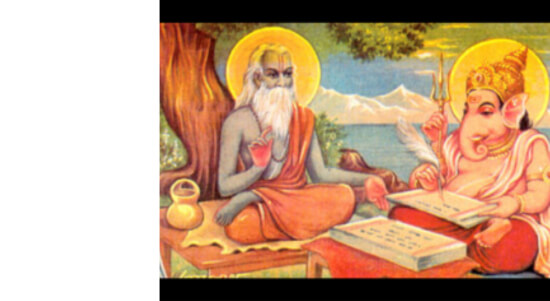
Essay On Veda Vyasa – The Great Sage of India
This is an essay on Veda Vyasa, he is known for writing the Mahabharata and compiling the Vedas. His original name was Krishna Dvaipayana.
The land of India has been blessed with great sages from time immemorial, and the greatest of them all is Veda Vyasa. Here is an essay on Veda Vyasa in English that would help students to script their own version. Veda Vyasa is of course best known as the one who wrote the great Indian epic Mahabharata. We are sure that you find this essay about Veda Vyasa as useful as our other essays on the great Maratha king Shivaji , Mahatma Gandhi , and other essays on the festivals of India.
Veda Vyas is believed to be one of the greatest of the ancient sages of India. It is hence natural that we need to have some knowledge about him, his life, and his achievements. This essay on Veda Vyasa in English aims to present in a simple way useful information about Veda Vyasa.
Essay On Veda Vyasa In English
Veda Vyasa is a sage who lived more than 3,000 years ago. He was the son of the sage Parashara who is believed to be the author of the first Purana, the Vishnu Purana. Another great sage Vasistha was the grandfather of Veda Vyasa, and his mother was Satyavathi.
Veda Vyas was named as Krishna Dvaipayana, as he was dark-skinned and born on an island. He was born on the Purnima (Full Moon) day of the Ashadha month of the Hindu calendar. His birth anniversary is also celebrated as Vyasa Jayanti which coincides with the celebration of Guru Purnima. The day is dedicated to the worship of Gurus or teachers and is celebrated by Hindus, Buddhists, and Sikhs.
Veda Vyasa was the grandfather of both the Pandavas and the Kauravas who fought with each other in the Kurukshetra war of the Mahabharata. Thus Veda Vyasa was a critical character and a witness to the happenings that he later described in the Mahabharata .
Krishna Dvaipayana was the original name of Veda Vyasa. He is credited with the herculean task of editing and classifying the Vedas into 4 Vedas, namely; Rig Veda, Yajur Veda, Sama Veda, and Atharva Veda. This is the reason for the name Veda Vyas which in Sanskrit translates as, “compiler of the Vedas.”
Apart from the Vedas, Maharshi Veda Vyas is credited with the writing of 18 of the major Puranas. which include Matsya Purana, Markandeya Purana, Varaha Purana, and Vamana Purana, among others. But, his most well-known contribution remains the writing of the Mahabharata. According to legend, he dictated the Mahabharata and the Puranas to Lord Ganesha , who wrote them down for him.
The importance of Veda Vyas is underlined by Lord Krishna himself who in Verse 37 of Chapter 10 of the Bhagavad Gita , declares that “of the sages, I am Vyasa.” Veda Vyasa is one of the Chiranjeevis, or immortals of Hindu mythology, which means that there is no death for him. The other Chiranjeevis are Hanuman, Vibhishana, Ashwatthama, Kripacharya, Bali, Parashurama, and Markandeya.
An interesting fact to note is that according to the Vishnu Purana, Veda Vyas is a title for the compiler of the Vedas, who is an avatar of Lord Vishnu, himself.
We hope you found this essay on Veda Vyasa in English, not only useful but also interesting. We recommend that you use the information given here to write in your own words, an essay on Veda Vyasa. Please subscribe to our blog for essays on various other interesting topics, that are sure to be of use to you. Also, do not forget to connect with us on our social media channels, including Instagram, and Twitter. We wish you a very happy and enlightening Guru Purnima and Vyasa Jayanti.

Thanks for visiting our site nirvandiaries.com and taking the time to read this post.
If you wish to collaborate or work with us then reach us at [email protected]
We’d love it if you’d comment by sharing your thoughts on this post and share this post on social media and with your friends.
Follow our journey on our social media channels: Facebook Twitter Instagram Pinterest
Also check out these Posts:
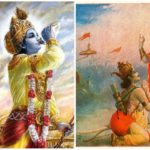
Leave a Comment Cancel Reply
Your email address will not be published. Required fields are marked *
Save my name, email, and website in this browser for the next time I comment.
Privacy Overview
| Cookie | Duration | Description |
|---|---|---|
| cookielawinfo-checkbox-analytics | 11 months | This cookie is set by GDPR Cookie Consent plugin. The cookie is used to store the user consent for the cookies in the category "Analytics". |
| cookielawinfo-checkbox-functional | 11 months | The cookie is set by GDPR cookie consent to record the user consent for the cookies in the category "Functional". |
| cookielawinfo-checkbox-necessary | 11 months | This cookie is set by GDPR Cookie Consent plugin. The cookies is used to store the user consent for the cookies in the category "Necessary". |
| cookielawinfo-checkbox-others | 11 months | This cookie is set by GDPR Cookie Consent plugin. The cookie is used to store the user consent for the cookies in the category "Other. |
| cookielawinfo-checkbox-performance | 11 months | This cookie is set by GDPR Cookie Consent plugin. The cookie is used to store the user consent for the cookies in the category "Performance". |
| viewed_cookie_policy | 11 months | The cookie is set by the GDPR Cookie Consent plugin and is used to store whether or not user has consented to the use of cookies. It does not store any personal data. |
The Vedas and Upanishads: Similarities and Differences Essay
- To find inspiration for your paper and overcome writer’s block
- As a source of information (ensure proper referencing)
- As a template for you assignment
Four Vedas - English Translation

Related Papers
Srini Kalyanaraman
Materialistic interpretation of मधु-विद्या Yajña is issuance, liberation of Soma. Soma is rock, Soma is wealth. Soma is मधु माक्षिकम् = मधुधातु सुवर्णमाक्षिक 'a kind of yellow pyrites'. Why did Indra use bones of sage Dadhica (RV 1.116.12) to make his weapon, thunderbolt? Maybe, he used the bones and bone ashes to make cupels to obtain purified metals from ores (pyrites). Brass moulds for making cupels. Cupellation, using cupels, is a refining process in metallurgy to separate metals like gold and silver from base metals like lead, coper, zinc, arsenic, antimoy or bismuth present in the ore (pyrites). “Cupels were manufactured in a very careful way. They used to be small vessels shaped in the form of an inverted truncated cone, made out of bone ashes. According to Georg Agricola, the best material was obtained from burned antlers of deer although fish spines could work as well. Ashes have to be ground into a fine and homogeneous powder and mixed with some sticky substance to mould the cupels. Moulds were made out of brass with no bottoms so that the cupels could be taken off. A shallow depression in the centre of the cupel was made with a rounded pestle. Cupel sizes depend on the amount of material to be assayed.” https://en.wikipedia.org/wiki/Cupellation दध्य्--च् [p= 468,2] "sprinkling द्/अधि " (cf. °धि-क्र्/आ and घृत्/आ*ची) N. of a mythical ऋषि or sacrificer ( RV. i , 80 , 16 and [called अङ्गिरस्] 139 , 9 [आङ्गिरस] Ta1n2d2yaBr. xii , 8 ; son of अथर्वन् [cf. आथर्वण्/अ] RV. vi , 16 , 14 BhP. iv , 1 , 42 ; having the head of a horse and teaching the अश्विन्s to find in त्वष्टृ's house the म्/अधु or सोम RV. i , 116 f. and 119 ; ix , 108 , 4 ; favoured by इन्द्र [x , 48 , 2] who slays 99 वृत्रs or foes with a thunderbolt made of his bones i. 84 , 13 BhP. vi , 11 , 20 ; viii , 20 , 7 ; propounder of the ब्राह्मण called म्/अधु S3Br. iv , xivBhP. vi , 9 , 50ff.) Dadhyañc Ātharvaṇa with the head of a horse, taught madhu vidyā to Aśvins and to Indra. (Br̥hadāraṇyaka Up. 2.5.16). मधु-विद्या [p= 780,3] f. "science of sweetness", N. of a partic. mystical doctrine Br2A1rUp. S3am2k. SV. Sch. &c मधु madhu - Ved. Soma juice -धातुः a kind of yellow pyrites (सुवर्णमाक्षिक). -मधु माक्षिकम् = मधुधातु Dadhi-krā is the name of a divine horse or bird, personification of the morning Sun, which is addressed in the Rigveda.[1]He is invoked in the morning along with Agni, Ushas and the Asvins. Although the etymological origin is not certain, it has been suggested that the name is derived from dadhi meaning thickened milk and kri meaning to scatter. This scattering could attributed to the effect of the morning sun on dew or hoar frost. https://en.wikipedia.org/wiki/Dadhikra Potapovka culture, ca. 2500—2000 BC. A Bronze Age culture centered on the Samara bend in the middle Volga region, projecting well east into the Samara River valley... One burial has the corpse's head replaced with that of a horse, reminiscent of the Vedic account of how the Asvíns replace the head of the priest Dadhyañc Artharvana with that of a horse so that he could reveal the secret of the sacred drink. —EIEC "Potapovka Culture"
samiddha, idhma are manifestations ofअग्नि agni Narāśaṁsa, 'praise of men' and Tanūnapāt, 'devourer of clarified butter'. Agniṣṭhā is that corner of the Yūpa towards the fire. Agni is the central divinity of a yajña. Adoration of Agni in R̥gveda Chandas is an unparalleled, inspired adoration of breath-taking splendour, with awe and wonder at the cosmic dance, the tāṇḍava nr̥tyam -- in the history of literature of civilizations. Excerpts from शब्दकल्पद्रुमः and वाचस्पत्यम् -- two ancient encyclopaedias provide the semantic framework of extraordinary metaphors of adoration of Lat. igni-s ; Lith. ugni-s ; Slav. ognj; Samskr̥tam agni. अग्निः, पुं, (अङ्गयन्ति अग्य्रं जन्म प्रापयन्ति इतिव्युत्पत्त्या हविः प्रक्षेपाधिकरणेषु गार्हपत्याहवनी-यदक्षिणाग्निसभ्यावसथ्यौपासनाख्येषु षड्ग्निषु ।यद्वा अङ्गति ऊर्द्ध्वं गच्छति इति । अगि गतौ । ... Gargya Narayana's commentary mentions the following 10 āprī sukta.
The purport of this narrative is to present ancient textual descriptions of Soma as a pleasure-giving material which is processed and realized in a Soma samsthā yāga. The objective of Soma samsthā yāga is to fulfill the desire to be 'shining wealthy' –the refrain is: athā no vasyasaskṛdhi -- to obtain purified, potable Soma. Soma is metaphored as an eatable, drink for the divinities adored and worshipped (NOT a drink for the mortals or the yajñika, 'worshipper'). The purport of this narrative is delineation of a causal order, outline wealth-creation activities by these ancient artisans, as evidenced from ancient texts such as Atharva-, Ṛg-veda and Mahābhārata. It is instructive that the word for the two semantics: dhanam, 'wealth' and yajña is medhā (synonym of Soma samsthā yāga). The Indus Script hieroglyph which signifies medhā is meḍha 'twist, curl, knot'. The hieroglyph is highlighted on a copper plate inscription narrating a Soma samsthā yāga, and on another copper plate data archiving metalwork catalogues). There are other hieroglyphs/hypertexts in Indus Script Corpora of over 8000 inscriptions, rendering the same rebus renderings in Meluhha (mleccha) speech forms. This is presented in the levels of Ādibhautika and Ādidaivika framework of Itihāsa of Bhāratam Janam. Ādhyātmikā and turīya (truth) levels of the Itihāsa framework are yet to be narrated. Association and significance of वालखिल्या, gaṇa, kubera, kharva 'dwarfs' 'wealth' with sādhya, virāj are presented. The refrain in RV 9.4.1 to 10 is: athā no vasyasaskṛdhi ‘make us shining wealthy.' यशस् [p= 848,2]n. beautiful appearance , beauty , splendour , worth RV. AV. VS. S3Br. Gr2S3rS.; wealth. वस् [p= 930,1] (a Vedic root connected with √1. उष् q.v. ; not in Dha1tup. ) cl.6 P. , उच्छ्/अति (pf. उव्/आस , ऊष्उः RV. &c ; aor. अवात् [?] AV. ; अवस्रन् RV. ; Cond. अवत्स्यत् S3Br. ; Ved. inf. व्/अस्तवे, -/उषि) , to shine , grow bright (esp. applied to the dawn) RV. ; to bestow by shining upon (dat.) ib. i , 113 , 7 ; (with दूर्/ए) to drive away by shining ib. vii , 77 , 4 : Caus. वास्/अयति , to cause to shine RV. [cf. वसर् in वसर्-हन् ; Lat. ve1r &c ] sādhya are a class of celestial beings, pitṛs, ancestors (manes) who were the initiators of the first soma yāga and from which yāga the first dharma-s (duties, knowledge of cosmic order) were born तानि धर्माणि प्रथमानि आसन् virāj is an enunciation of cosmogonical, ritual, and metrical doctrine and a glorification of the mystical abstraction (AV 8.9, 10) Virāj is the aggregate of all human beings. वि-राज् [983,1] f. a particular Vedic metre consisting of four पादs of ten syllables each (and therefore also a symbolical N. of the number " ten " ; in RV. x , 130 , 5 this metre is represented as attaching itself to मित्र and वरुण , and in AitBr. i , 4 विराज् is mystically regarded as " food " , and invocations are directed to be made in this metre when food is the especial object of prayer ; in prosody विराज् is applied to any metre defective by two syllables RPra1t. ) virāj is thus comparable to mleccha (cognate meluhha) a speech-form which abounds in mis-pronunciations and ungrammatical utterances. mleccha is the semantic framework for the Indus Script corpora as hieroglyph/hypertext metalwork catalogues, a datamine of wealth-creation activities. RV 10.90.1 notes that Purusha seed of the universe is 10” dia. RV 10.090.01 Puruṣa, who has a thousand heads, a thousand eyes, a thousand feet, investing the earth in all directions, exceeds (it by a space) measuring ten fingers. [purus.a = embodied spirit; or, virāj, the aggregate of all living beings, spirit embodied in the egg of Brahmā, i.e., the universal spirit animating all creation. Thousand = an infinite number; the human soul, extending from the navel, takes upits abode in the heart or the human breast; the supreme soul, having animated the universe, is present in man, either in a minute form or of definite dimensions]. RV 10.90.1. A THOUSAND heads hath Puruṣa, a thousand eyes, a thousand feet. On every side pervading earth he fills a space ten fingers wide. Ṛgveda notes that ancient sādhya initiated the yajña, they are soma-sad, 'Soma-pressers', they are venerated as pitṛs, 'manes'. Their attribute is virāj, 'illumine, shine', deified as sovereign. virāj beget puruṣa, corporeal forms. In Atharvaveda (viii.10,28), virāj personified as mother, begets Vaisrāvaṇa Kubera. Kubera was her 'calf', Soma was her 'calf.' Kubera is a dwarf, the king of Yakṣa, the owner of treasures of the world. ऐलविल ailavilaऐलविल N. of Kubera. ऐलविल [p= 234,3] m. or ऐलविड (cf. ऐडविड) a descendant of इलविल, N. of दिलीप MBh. vii , 2263; a descendant of इलविला , N. of कुवेर MBh. Hariv. Ba1lar. kubē(vē)rḥ कुबे (वे) रः [कुत्सितं बे (वे) रं शरीरं यस्य सः] 1 The god of riches and treasure and the regent of the north- ern quarter; कुबेरगुप्तां दिशमुष्णरश्मौ गन्तुं प्रवृत्ते समयं विलङ्घ्य Ku.3.25 (vide Malli. thereon). [Kubera is the son of Viśravas by Iḍāviḍā, and thus the half brother of Rāvaṇa. Besides, being the lord of riches and regent of the north, he is the king of the Yakṣas and Kin- naras, and a friend of Rudra. His abode is Kailāsa. He is represented as being deformed in body-having three legs, only eight teeth, and a yellow mark in place of one eye.] -2 N. of a tree. -Comp. -अक्षी N. of a plant (Mar. सागरगोटी). -अद्रिः, -अचलः an epithet of mountain Kailāsa. -दिश् f. the north. -बान्धवः N. of Śiva. Kubera is a friend of रुद्र [Hariv. 13131] RV 10.090.16 By sacrifice the gods worshipped (him who is also) the sacrifice; those were the first duties. Those great ones became partakers of the heaven where the ancient deities the Sa_dhyas abide. Griffith: RV 10.90.16 Gods, sacrificing, sacrificed the victim these were the earliest holy ordinances. The Mighty Ones attained the height of heaven, there where the Sadhyas, Gods of old, are dwelling.
R̥gveda Sarasvatī River & Civilization from ca.7570 BCE -- Ancient Maritime Tin Route & Arthaśāstra wealth of Bhārata Rāṣṭram documented in Indus Script hypertexts Over 4 millennia, Bhāratam Janam created the wealth of a Rāṣṭram which accounted for33% of World Gross Domestic Product (GDP). This wealth-creation was achieved by the following factors: 1. Organization of life-activities in workers' and seafaring merchants' guilds creating a Comnonwealth of śreṇi as an organized corporate form, a factor of production together with land, labour and capital 2. Participating in maritime trade along an Ancient Tin Route which linked Hanoi (Vietnam) and Haifa (Israel) 3. Harnessing minerals wealth through metalwork including cire perdue (lost-wax) metal castings and creation of metal alloys 4. Domestication of cotton and organized rice farming from 6th millennium BCE 5. Living life led by a universal ethic, dharma for abhyudayam, general welfare and nihśreyas 'uniting ātman with paramātman, transit from Being to Becoming'). Sarasvati Civilization Chronology, Classification of dates attested at Bhirrana (After Dixit & Mani, 2017) Settled life and continuous settlements at Bhirrama on the Drishadvati River Basin, starts from c. 7380 – 6201 BCE The region inhabited by Bhāratam Janam has as its axis the Sarasvatī RV 6.61.9: sā́ no víśvā áti dvíṣaḥ svásṝ anyā́ ṛtā́ varī átann áheva sū́ryaḥ. ‘[Sarasvati] who follows Cosmic Order has spread us [the five Tribes] beyond enmities, and her sister rivers as the Sungod the days.’ RV 6.61.12 mentions pañcajanāh, 'five artisan groups, five peoples'; these people moved out of the larger Saptasindhu region. Druhyus, Anus, Purus, Yadus and Turvasus are the five peoples. Baudhāyana’s Śrautasūtra 18.14 refers to two migrations: the eastern one Āyava into the Gangetic plains and further; the western one Āmāvasa comprising the Gāndhāris, Parśus (= Persians) and Arāttas (= Ararat, Urartu?). The Persians or Iranians record in their texts that they had passed from Haptahǝndu and Haraxvaiti. These movements east and west of Kurukṣetra Sarsvati River Basin explain the continued use of Indus Script to document wealth accounting ledgers of metalwork in contact areas of Ancient Near East and Ancient Far East. It is possible that northwestward migration of Bhāratam Janam would have progressed from Bactria rather than directly from Saptasindhu regionr. The date for these westward movements would be much older than is thought and naturally after the end of the ice age ca. 10000 BCE. Porus presents a steel sword to Alexander on the banks of Jhelum (ca.321 BCE) Painting in Steel Authority of India Institute, Ranchi. In the backgrouns are smiths atwork. Himalayan range (great water tower serving ca. 2 billion people) measuring rod of the globe from Hanoi, Vietnam to Teheran, Iran. Dynamic due to uplift of 1 cm every year as Indian plate juts into European plate at 6 cm per year and lifts it up causing plate tectonics (earthquakes). The perennial great river systems out of Manasarovar are: Yangtse-Huanghe, Brahmaputra, Irrawaddy, Salween, Mekong. The largest tin belt of the globe is in Mekong River delta hence the Dong Son Bronze drums. Bhāratam Janam have documented their wealth-creating metalwork activities of the Bronze Age in over 8000 inscriptions (hypertexts) whose meanings have been presented in a trilogy: Epigraphia Indus Script -- Hypertexts & Meanings (2017). This work constitutes the rimary source to narrate the Bhāratīya Arthaśāstra Itihāsa. Two other principal sources of wealth-creation related to domestication of cotton and advances in related textile technologies and organized farming for millets, maize and other cereals. Moulherat, C., Tengberg, M., Haquet, J.-F. & Mille, B. 2002. "First Evidence of Cotton at Neolithic Mehrgarh, Pakistan: Analysis of Mineralized Fibres from a Copper Bead', Journal of Archaeological Science, 29 : 1393-1401.https://www.academia.edu/16390522/First_Evidence_of_Cotton_at_Neolithic_Mehrgarh_Pakistan_Analysis_of_Mineralized_Fibres_from_a_Copper_Bead Domestication of cotton has been datedto 6th millennium BCE. "The metallurgical analysis of a copper bead from a Neolithic burial (6th millennium) at Mehrgarh, Pakistan, allowed the recovery of several threads, preserved by mineralization. They were characterized according to new procedure,combining the use of a reflectedlight microscope and a scanning electron microscope, and identified as cotton(Gossypium sp.). The Mehrgarh fibres constitute the earliest known example of cotton in the Old World and put the dateof the first use of this textile plant back by more than a millennium. Even though it is not possible to ascertain that thefibres came from an already domesticated species, the evidence suggests an early origin, possibly in the Kachi Plain, of one of the Old World cottons." Lahurdewa excavation. Remains of rice on pottery The three pure tin ingots with Indus Script hypertexts were found in a shipwreck in Haifa. Tin was sourced from the largest tin belt of the globe on the river basins of Himalayan riveres: Mekong, Irrawaddy and Salween. The hypertexts are: ranku 'liquid measure' ranku 'antelope' rebus: ranku 'tin' dāṭu 'cross' rebus: dhatu 'mineral' mũh 'face' rebus: mũhā 'ingot'; mũhã̄ 'the quantity of iron produced at one time in a native furnace'. Thus, the hypertext message is: tin mineral ingot. The use of Indus Script hypertexts is also attested on the tympanum and Dong Son/Karen bronze drums with hypertexts: maraka 'peacock' rebus: marakaka loha 'copper calcining metal'; karibha 'elephant' rebus: karba 'iron'; Kur. mūxā frog. Malt. múqe id. / Cf. Skt. mūkaka- id. (DEDR 5023) rebus: mũhā 'ingot'; mũhã̄ 'the quantity of iron produced at one time in a native furnace'; kang 'crane' Rebus: kang 'brazier, fireplace' The links between Munda/Santali (Austro-Asiatic languages) and MonKhmer languages have been established and there is a remarkable correlation between the bronze age settlements of Ancient Indian and Ancient Far East and the spread of Mon-Khmer (Austro-Asiatic) languages. Map of Bronze Age sites of eastern India and neighbouring areas: 1. Koldihwa; 2.Khairdih; 3. Chirand; 4. Mahisadal; 5. Pandu Rajar Dhibi; 6.Mehrgarh; 7. Harappa;8. Mohenjo-daro; 9.Ahar; 10. Kayatha; 11.Navdatoli; 12.Inamgaon; 13. Non PaWai; 14. Nong Nor;15. Ban Na Di andBan Chiang; 16. NonNok Tha; 17. Thanh Den; 18. Shizhaishan; 19. Ban Don Ta Phet [After Fig. 8.1 in: Charles Higham, 1996, The Bronze Age of Southeast Asia, Cambridge University Press]. Pinnow’s map of Austro-AsiaticLanguage speakers correlates with bronze age sites. Thus, an Ancient Maritime Tin Route linking Hanoi (Vietnam) and Haifa (Israel) is posited to explain the sources of tin to create the Tin-Bronze Revolution. This Maritime Tin Route along the Indian Ocean and Himalayan rivers predates the Silk Road by two milloennia, confirmed by the evidence of Indus Script hypertexts on Dong Son/Karen Bronze drums and presence of Ancient Bhāratam Janam in the Hinduised States of Ancient Far East attested by hundreds of octagonal rudrabhāga of hundreds of Śivalingas discovered in the Ancient Far East together with Gaṇeśa pratimā, Mulavarman's octagonal Yupas with inscriptions proclaiming performance of Soma Yajña. ... Period I (Neolothic) 7570-7180 BCE, 6689-6201 BCE Period IIA (Transitional Period): 6200-5850 BCE 5316-4775 BCE Period IIB (Early-Harappan): 4714-4360 BCE 3970-3640 BCE 3370-2890 BCE 3100-2880 BCE 3020-2700 BCE Period III (Mature Harappan) 2920-2640 BCE 2856-2414 BCE 2471-2273 BCE 2310-1980 BCE Period IV (Late Harappan) 1950-1640 BCE 1878-1839 BCE 16
Srinivasan Kalyanaraman
Vasu-s, wealth givers, Vṛṣākapi is a Rudra, hunter (Mṛgaśiras, Orion) This is an addendum to: Astronomical evidence dates ancient R̥gveda Soma yajña performances from ca.7th millennium BCE -- Narahari Achar https://tinyurl.com/ya969v73 ऋभुक्ष इन्द्र's thunderbolt L.(इन्द्र's) heaven Comm. on Un2. iv , 12; m. इन्द्र L. ऋभुक्षिन् Pa1n2. 7-1 , 85 ff.), N. of the above ऋभुs , and esp. of the first of them RV.; of the मरुत्s RV. viii. 7 , 9 ; xx , 2; great , best ([ Sa1y. ]) RV. viii , 93 , 34. Rhibhus or Ribhus (ṛbhú-, pl. ṛbhava, also called R̥bhuksin). Their name's meaning is "clever, skillful, inventive, prudent", cognate to Latin labor and Gothic arb-aiþs "labour, toil", and perhaps to English elf. Aitareya Brāhmaṇa III, 30 describes them as "sun's neighbours or pupils". Ribhus are artists who formed the horses of Indra, the carriage of the Ashvins, and the miraculous cow of Brihaspati, made their parents young, and performed other wonderful works which according to RV 4.51.6 were "done by the dawn". According to Yaska they also founded the yajña-s. ऋभु mfn. ( √रभ्) , clever , skilful , inventive , prudent (said of इन्द्र , अग्नि , and the आदित्यs RV. ; also of property or wealth RV. iv , 37 , 5 ; viii , 93 , 34 ; of an arrow AV. i , 2 , 3). Skilled artisans R̥bhu-s are founders of yajña, Vasu-s, wealth givers, Vṛṣākapi is a Rudra, hunter (Mṛgaśiras, Orion). I suggest that the skilled artisans and seafaring merchants are the architects of Sarasvati Civilization who have left for us the heritage of over 8000 Indus Script inscriptions which are wealth accounting ledgers, metalwork catalogues. The astronomical references point to 8th millennium BCE as the date the yajña wer founded. Vṛṣākapi is a Rudra. Viṣṇu Purāṇa 1.5 lists eleven Rudra: Hara, Bahurupa, Tryambaka, Aparajita, Vṛṣākapi, Śambhu, Kaparddi, Raivata, Mrigavyadha, Sarva, and Kapāli. Rudra (/ˈrʊdrə/; Sanskrit: रुद्र) is a Rigvedic deity, associated with wind or storm and the hunt. In RV 7.46, Rudra is described as armed with a bow and fast-flying arrows रुद्र m. " Roarer or Howler " , N. of the god of tempests and father and ruler of the रुद्रs and मरुत्s (in the वेद he is closely connected with इन्द्र and still more with अग्नि , the god of fire , which , as a destroying agent , rages and crackles like the roaring storm , and also with काल or Time the all-consumer , with whom he is afterwards identified ; though generally represented as a destroying deity , whose terrible shafts bring death or disease on men and cattle , he has also the epithet शिव , " benevolent " or " auspicious " , and is even supposed to possess healing powers from his chasing away vapours and purifying the atmosphere ; in the later mythology the word शिव , which does not occur as a name in the वेद , was employed , first as an euphemistic epithet and then as a real name for रुद्र , who lost his special connection with storms and developed into a form of the disintegrating and reintegrating principle ; while a new class of beings , described as eleven [or thirty-three] in number , though still called रुद्रs , took the place of the original रुद्रs or मरुत्s: in VP. i , 7, रुद्र is said to have sprung from ब्रह्मा's forehead , and to have afterwards separated himself into a figure half male and half female , the former portion separating again into the 11 रुद्रs , hence these later रुद्रs are sometimes regarded as inferior manifestations of शिव , and most of their names , which are variously given in the different पुराणs , are also names of शिव ; those of the Va1yuP. are अजैकपाद् , अहिर्-बुध्न्य , हर , निरृत , ईश्वर , भुवन , अङ्गारक , अर्ध-केतु , मृत्यु , सर्प , कपालिन् ; accord. to others the रुद्रs are represented as children of कश्यप and सुरभि or of ब्रह्मा and सुरभि or of भूतand सु-रूपा ; accord. to VP. i , 8, रुद्र is one of the 8 forms of शिव ; elsewhere he is reckoned among the दिक्-पालs as regent of the north-east quarter) RV. &c (cf.RTL. 75 &c ) Mṛgaśira nakṣatra extends from after 23°20 in Vṛṣabha Rāśi up to 6°40 in Mithuna. Star is governed by mars and the presiding deity or God is a Soma God. Soma mean Chandra or Moon God. He hold amrita (nectar or eternity poison ). Symbol is Antelope or Deer. The first two carana/pada (quarters) of this nakṣatra are part of Vṛṣabha Rāśi (Devanagari: वृषभ) or Taurus. The latter half of this star belong to Mithuna Rāśi(Devanagari: मिथुन) or Gemini (from 23°20’ Taurus to 6°40’ Gemini). stars in λ, φ1, φ2 Orionis 7.048.01 R.bhu, (Vibhu), and Va_ja, leaders of rites, possessors of opulence, be exhilarated by our effused (libation); may your active and powerful (horses) bring to our presence your chariot, beneficial to mankind. [r.bhuks.an.o va_jah, the use of the plural implies that the three brothers are intended]. 7.048.02 Mighty with the R.bhus, opulent with the Vibhus, may we overcome by strength, the strength (of our foes); may Va_ja defend us in battle; with Indra, our ally, may we destroy the enemy. [R.bhus: r.bhur r.bhubhih vibhvo vibhubhih: r.bhu and uru = great; vibhu vibhvah = rich or powerful]. 7.048.03 They verily, (Indra and R.bhus), overcome multitudes by their prowess; they overcome all enemies in the missile conflict; may Indra, Vibhvan, R.bhuks.in and Va_ja, the subduers of foes, annihilate by their wrath the strength of the enemy. [Missile: uparata_ti: upara = upala, a stone; upalaih pa_s.a_n.asadr.s'air a_yudhai ta_yate yuddham, war that is waged with weapons like stones, is uparatati]. 7.048.04 Grant us, deities, this day opulence; may you all, may you all, well-pleased alike, be (ready) for our protection; may the exalted (R.bhus) bestow upon us food; and do you (all) ever cherish us with blessings. [R.bhus: vasavah = Vasus; pras'asyah, an epithet of R.bhavah]. Vṛṣākapi (वृषाकपि):—One of the Eleven Rudras (ekādaśa-rudra), according to the Agni-purāṇa. The Agni Purāṇa is a religious text containing details on Viṣṇu’s different incarnations (avatar), but also deals with various cultural subjects such as Cosmology, Grammar and Astrology. Vṛṣākapi (वृषाकपि).—A Rudra, and a son of Bhūta and Sarūpā: Fought with Jambha in the Devāsura war. Viṣṇu Purāṇa 1.5 being devoted to it, was the wife of Prabhasa, the eighth of the Vasus, and bore to him the patriarch Viswakarma, the author of a thousand arts, the mechanist of the gods, the fabricator of all ornaments, the chief of artists, the constructor of the self moving chariots of the deities, and by whose skill men obtain subsistence. Ajaikapad, Ahirvradhna, and the wise Rudra Twashtri, were born; and the self born son of Twashtri was also the celebrated Viswarupa. There are eleven well known Rudras, lords of the three worlds, or Hara, Bahurupa, Tryambaka, Aparajita, Vrishakapi, Sambhu, Kaparddi, Raivata, Mrigavyadha, Sarva, and Kapali 17; but there are a hundred appellations of the immeasurably mighty Rudras 18.
-- Itihāsa in Indus Script Cipher of sculptures of नाचण्याचा फड A nach house. -- फडनीस 'keeper of register' of फडा phaḍā 'metals manufactory', paṭṭaḍe 'smithy', -- Nr̥tya Gaṇeśa, of नाचण्याचा फड 'nach house', cobrahood, lotus, tridhātu Gaṇeśa karaṇa, 'dance posture' karaṇa 'scribe' -- Why is Gardez Gaṇeśa (Mahāvināyaka) shown with cobrahood, tiger's paw, decorations and in dance-posture? Dance posture is karaṇa, 'dance posture' Rebus: karaṇa 'scribe'. panja 'feline paw' rebus: panja 'kiln, furnace'. फडा phaḍā 'cobrahood' rebus: फडा phaḍā 'metals manufactory), paṭṭaḍe 'smithy, workshop'. He is फडनीस 'keeper of register' shown in नाचण्याचा फड 'nach house' -- with a karaṇa, 'dance posture' to signify rebus that he is karaṇa 'scribe'. -- फड phaḍa is a place of public business or public resort; as a court of justice, an exchange, a mart, a counting-house, a custom-house, an auction-room. -- नाचण्याचा फड A nach house, गाण्याचा or ख्यालीखुशालीचा फड A singing shop or merriment shop. Dancing gaṇa-s. Badami caves. Narratives of Badami caves. Trivikrama and dancing dwarfs. "Ganas", base of the Kailasanatha temple. Those who have been most devoted to Siva win the boon of being perpetually close to him. These are the "ganas", who inhabit the walls of Siva temples. Having gained the opportunity of being with Siva, they are full of joy and share this with the worshipper through their dancing, music and frolicsome pranks. https://frontline.thehindu.com/static/html/fl2501/stories/20080118504906500.htm A row of yaali and a row of boothagana are below the vimana. Inquisitive ganas indeed, playing musical instruments and dancing! Valeeswaram temple has a beautiful stone vimana, built in 10th C CE, majorly by Cholas/ Worship of Śivalinga by Gandharvas - Śunga Period - Bhuteśwar - ACCN 3625 - Government Museum - Mathura 2013-02-24 6098.JPG Sculptural frieze. Association of kharva, 'dwarfs' with smelter and śivalinga. Bhuteśvar. Mathura Museum. In this long frieze on the vimana of Vettuvan Kovil ganas can be seen dancing and playing musical instruments. "...Vettuvan Kovil, a monolithic temple hewn out of a hill. The late C. Sivaramamurti, who was the Director of the National Museum in New Delhi, in his book Kalugumalai and Early Pandyan Rock-cut Shrines, describes it as “by far the most beautiful rock-cut temple of the Pandya period… a half-finished free-standing monolith which recalls the famous temple of Siva at Ellora”. The Jaina sites at Kazhugumalai and Vettuvan Kovil are under the State Department of Archaeology." https://frontline.thehindu.com/static/html/fl2521/stories/20081024252106500.htm (dh)makara 'makara' rebus: dhmākāra 'bellows blower, blacksmith' disgorges the artisan, sculptor, smith.. https://tamilnadu-favtourism.blogspot.com/2016/07/vettuvan-koil-kalugumalai-thoothukudi_8.html Sculptural frieze of dancing dwarfs in: Vettuvan Koil, Kalugumalai, Thoothukudi. http://tamilnadu-favtourism.blogspot.in/2016/07/vettuvan-koil-kalugumalai-thoothukudi_8.html Kailasanatha temple, Kanchipuram. Dancing Gaṇas (Dancers include karibha, ibha 'elephant' rebus: karba, ib 'iron'; karaṇa, 'dance posture' karaṇa 'scribe'; baḍhi 'boar' rebus: baḍhi 'worker in iron and wood'; vāḍī 'merchant'. These are Gaṇeśa, Varāha (baḍiga, 'artificer') metaphors of wealth-accounting ledgers, metalwork catalogues in Indus Script Cipher.. Dancing Butha Ganas @ Kailasanathar Temple-Kanchipuram-Tamilnadu Cobrahood venerated. Sanchi. फडा phaḍā f (फटा S) The hood of Coluber Nága &c. 2 f m A common term for the joints of Flat-jointed prickly pear. 3 A root (as of ginger or turmeric) which separates into cloves, a race or sprig. 4 m An end or a fragment of a branch of the Date-tree: also a spike or pinnate leaf of it.फडी phaḍī f (Dim. of फडा) The expanded hood of Coluber Nága &c. फडी फिंदारणें To expand its hood--the नाग. 2 fig. To glare at. Gardez Gaṇeśa with Indus Script hypertexts फड 'cobra hood' (फडनीस phaḍanīsa 'scribe' of) karaṇḍa mukuṭa to signify खरडा kharaḍā,'wealth-accounting ledger', करडा karaḍā 'hard alloy of iron' https://tinyurl.com/yd4abfqs Broad strap antarīya on Gardez Gaṇeśa pratimā is Indus Script hypertext to signify metals (iron) manufactory of Sarasvati civilization. Amarakośa provides a synonym for Gaṇeśa with the expression tri-dhātu, 'three minerals'. The pratimā has vivid iconographic details to further elaborate on the metaphor of Gaṇeśa an iron smelter, a wealth-accounting ledger keeper, a scribe. Gaṇeśa wears an unusual crown, shaped like a wicker basket. The rebus reading of the crown worn by Gaṇeśa is karaṇḍa hieroglyph करंडी karaṇḍī f (Dim. of करंडा) A little covered basket of bamboo. karaṇḍa 'wicker-basket' rebus: करडा karaḍā 'Hard from alloy--iron, silver &38' A similar sounding word signifies that Gaṇeśa is a scribe, writer: खरड kharaḍa f (खरडणें) A hurriedly written or drawn piece; a scrawl; a mere tracing or rude sketch.खरडा kharaḍā a day-book; a note-book. Thus, Gaṇeśa is keeper of a day-book, wealth-accounting ledger. These metaphors are conveyed by the karaṇḍa-shaped mukuṭa 'crown' worn by Mahāvināyaka of Gardez. Elephant trunk: karibha, ibha 'elephant' rebus: karba, ib 'iron'; ib 'stylus' (as in English nib of stylus). Gaṇeśa wears a yajñopavita, 'sacred thread' adorned with a cobra-hood:phaḍā'cobra hood'rebus phaḍā,paṭṭaḍe 'metals manufactory'. kola 'tiger' rebus: kol 'working in iron' kolhe 'smelter' kolle 'blacksmith. panja 'claw of beast, feline paw' rebus: panja 'kiln'. Thousands of Gaṇeśa pratimā also show a mouse:mūṣa 'mouse' rebus: mūṣa 'crucible'. Thus, Gaṇeśa is an iron worker producing crucible steel. This metallurgical competence makes him the leader of the guild, ironworker guild-master, Mahāvināyaka.
Jos P V Boven
The most prominent ancient spiritual wisdom, from which all spiritual systems and phylosophies are derived in Hinduism, are the four Vedas: Rig Veda, Yajur Veda, Sama Veda, Atharva Veda. All Yoga-systems, including Sahaja Yoga (Vishwa Nirmala Dharma), are tributary for their contents to the Vedas, Upanishads and Puranas. But only Shri Mataji Nirmala Davi succeeded in giving 'en masse'-realization.
See: Metaphors of Rāṣṭrī Suktam R̥gveda 10.125, signify tribute to guilds of pāñcāla, pañca jātā, 'five artisans', seafaring merchants of Sarasvati Civilization https://tinyurl.com/yadqjo2d Listen to https://www.youtube.com/watch?v=-E5xPEsP1A4 (3:29) A rendering of RV 10.125, "Devī Suktam", also called Rāṣṭrī sūktam (RV 10.125). Metaphors of Rāṣṭrī sūktam (RV 10.125) signify navigable Sarasvatī river. The river moves & creates wealth of a nation. These metaphors are replicated as Meluhha hypertexts, recording metalwork catalogues on 8000+ Indus Script inscriptions. The Indus Script inscriptions are wealth-accounting ledgers. Rāṣṭrī if feminine form of Rāṣṭram, 'nation'. The sūktam (RV 10.125) is rendered as a soliloquy, an oration or proclamation by R̥ṣikā vāgāmbhr̥ṇī. The word vāgāmbhr̥ṇī is a metaphor which signifies: vāc, vāk 'speech, knowledge' वाच् f. (fr. √ वच्) speech , voice , talk , language (also of animals) , sound (also of inanimate objects as of the stones used for pressing , of a drum &c ) RV. &c(वाचम्- √ऋ , ईर् , or इष् , to raise the voice , utter a sound , cry , call); a word , saying , phrase , sentence , statement , asseveration Mn. MBh. &c (वाचं- √वद् , to speak words ; वाचं व्या- √हृ , to utter words ; वाचं- √दा with dat. , to address words to ; वाचा सत्यं- √कृ , to promise verbally in marriage , plight troth); Speech personified (in various manners or forms e.g. as वाच् आम्भृणी in RV. x , 125 ; as the voice of the middle sphere in Naigh. and Nir. ; in the वेद she is also represented as created by प्रजा-पति and married to him ; in other places she is called the mother of the वेदs and wife of इन्द्र ; in VP. she is the daughter of दक्ष and wife of कश्यप ; but most frequently she is identified with भारती or सरस्वती , the goddess of speech ; वाचः साम and वाचो व्रतम् N. of सामन्s A1rshBr. ; वाचः स्तोमः, a partic. एका*ह S3rS. ) ambhas 'water' अम्भस् n. (cf. अभ्र्/अ , /अम्बु) , water RV. &c , the celestial waters AitUp.; power , fruit fulness VS. and AV.; pl. (आंसि) collective N. for gods , men , Manes , and असुरs TBr. and VP. ;N. of a metre (consisting of 82 syllables) RPra1t. , (अस) , instr. in comp. for अम्भस् (e.g. अम्भसाकृत " done by water ") Pa1n2. 6-3 , 3; du. (असी) heaven and earth Naigh. r̥ṇī personification and feminine form of ऋण 'debt owed, fort': n. anything due , obligation , duty , debt (a Brahman owes three debts or obligations , viz. 1 . ब्रह्मचर्य or " study of the वेदs " , to the ऋषिs ; 2. sacrifice and worship , to the gods ; 3. procreation of a son , to the Manes TS. vi , 3 , 10 , 5 Mn. vi , 35 , &c ; in later times also , 4. benevolence to mankind and 5. hospitality to guests are added MBh. &c ) RV. AV. &c Mn. MBh. &c; n. a debt of money , money owed MBh. Mn. Ya1jn5.; n. (ऋणं √कृ , to get into debt Ya1jn5. ii , 45 ; °म्- √प्रा७प् , to become indebted Mn. viii , 107 ; °ं- √दा or √नी or प्र- √यम् , to pay a debt MBh. Mn.&c; °ं- √याच् , to ask for a loan Katha1s. ; °म् परी*प्स् , to call in a debt Mn. viii , 161); n. water; n. a fort , stronghold L. ; ([cf. Zd. arena.]) Thus, the expression vāgāmbhr̥ṇī signifies and is a metaphor for a knowledge/speech divinity who is a fortress of water and to whom debt is owed. The proclamation of R̥ṣikā vāgāmbhr̥ṇī in Rāṣṭrī sūktam (RV 10.125) is that debt is owed by all citizens of a nation, because the wealth of a nation is created by the fortress of water, a knowledge system, moving wealth cargo on the navigable waterway. The intimations of a navigable waterway are apparent from these expressions: अहं रुद्रेभिर्वसुभिश्र्चराम्यहमादित्यैरुत विश्र्वदेवैः । अहं मित्रावरुणोभा बिभर्म्यहमिन्द्राग्नी अहमश्र्विनोभा ॥ १ ॥ Griffith translation: RV 10.125.1. I TRAVEL with the Rudras and the Vasus, with the Adityas and AllGods- I wander. I hold aloft both Varuna and Mitra, Indra and Agni, and the Pair of Asvins. The metaphor of gathering and moving of wealth is seen in: अहं सोममाहनसं बिभर्म्यहं त्वष्टारमुत पूषणं भगम् । अहं दधामि द्रविणं हविष्मते सुप्राव्ये यजमानाय सुन्वते ॥ २ ॥ Griffith: RV 10.125.2 I cherish and sustain highswelling- Soma, and Tvastar I support, Pusan, and Bhaga. I load with wealth the zealous sdcrificer who pours the juice and offers his oblation The metaphor of a navigable waterway is seen in the proclamation अहं वसूनां संगमनी:राष्ट्री 'I am the gatherer and mover of wealth of a nation'; the verb is गम् Ved. cl.1 P. ग्/अमति ( Naigh. ; Subj. गमम् , ग्/अमत् [गमातस् , गमाथ AV. ] , गमाम , गमन् RV. ; with prepositions -गम्य or -गत्य Pa1n2. 6-4 , 38) to go , move , go away , set out , come RV. &c ; the semantic expansion of the metaphor is that cargo of metalwork wealth moves on the navigable waterway; that wealth is signified is indicated by the plural वसूनां संगमनी 'gatherer and mover of wealths'; वसु N. of the gods (as the " good or bright ones " , esp. of the आदित्यs , मरुत्s , अश्विन्s , इन्द्र , उषस् , रुद्र , वायु , विष्णु , शिव , and कुबेर) RV. AV. MBh. R.; n. (in वेद gen. व्/असोस् , व्/अस्वस् and व्/असुनस् ; also pl. , exceptionally m.) wealth , goods , riches , property RV. &c ( °सोष्-पति m. prob. " the god of wealth or property " AV. i , 12 [ Paipp. ?? असोष्-प्° , " the god of life "] ; °सोर्-ध्/आरा f. " stream of wealth " , N. of a partic. libation of घृत at the अग्नि-चयन AV. TS.Br. &c ; of the wife of अग्नि BhP. ; of the heavenly गङ्गा MBh. ; of sacred bathing-place ib. ; of a kind of vessel ib. ; °सोर्-ध्/आरा-प्रयोग m. N. of wk.); n. gold (» -वर्म-धर); n. a jewel , gem , pearl (» -मेखल); n. any valuable or precious object; a form of the sun MBh. iii , 146 Hariv. 13143 BhP. iii , 6 , 15. Thus, वसूनां संगमनी signifies, 'mover of wealthy cargo' (on the navigable waterway): अहं राष्ट्री संगमनी वसूनां चिकितुषी प्रथमा यज्ञियानाम् । तां मा देवा व्यदधुः पुरुत्रा भूरिस्थात्रां भूर्यावेशयन्तीम् ॥ ३ ॥ Griffith: RV 10.125.3 I am the Queen, the gathererup- of treasures, most thoughtful, first of those who merit worship. Thus Gods have stablished me in many places with many homes to enter and abide in. See 8000+ Indus Script Inscriptions deciphered: The expression सोममाहनसं combines two words: Soma and आहनस, which I submit is a pun on the words which means आहनस 'destroyer of the enemy' and also āhangar ‘blacksmith’ linked with and derived from aśani ‘thunderbolt’ cognate śyena ‘falcon’, sena ‘thunderbolt’. The semantics of aśani ‘thunderbolt’ leads to the expression āhangar ‘blacksmith’. (Pashto. Kashmiri)aśani ‘thunderbolt’ cognate śyena ‘falcon’, sena ‘thunderbolt’. The semantics of aśani ‘thunderbolt’ leads to the expression āhangar ‘blacksmith’. (Pashto. Kashmiri) P آهن āhan, s.m. (9th) Iron. Sing. and Pl. آهن ګر āhan gar, s.m. (5th) A smith, a blacksmith. Pl. آهن ګران āhan-garān. آهن ربا āhan-rubā, s.f. (6th) The magnet or loadstone. (E.) Sing. and Pl.); (W.) Pl. آهن رباوي āhan-rubāwī. (Pashto) In addition to रुद्रेभिर्वसुभि:सोम त्वष्टा पूषण भग are invoked; such an invocation is an adoration of the creators and promoters of artisans who create wealth: e.g., त्वष्टृ who is a metals/weapons-maker: m. a carpenter , maker of carriages (= त्/अष्टृ) AV. xii , 3 , 33; " creator of living beings " , the heavenly builder , N. of a god (called सु-क्/ऋत् , -पाण्/इ , -ग्/अभस्ति , -ज्/अनिमन् , स्व्-/अपस् , अप्/असाम् अप्/अस्तम , विश्व्/अ-रूप&c RV. ; maker of divine implements , esp. of इन्द्र's thunderbolt and teacher of the ऋभुs i , iv-vi , x Hariv. 12146 f. R. ii , 91 , 12 ; former of the bodies of men and animals , hence called " firstborn " and invoked for the sake of offspring , esp. in the आप्री hymns RV. AV. &c MBh. iv , 1178 Hariv. 587 ff. Ragh. vi , 32 ; associated with the similar deities धातृ , सवितृ , प्रजा-पति , पूषन् , and surrounded by divine females [ग्न्/आस् , जन्/अयस् , देव्/आनाम् प्/अत्नीस् ; cf. त्व्/अष्टा-व्/अरूत्री] recipients of his generative energy RV. S3Br. i Ka1tyS3r. iii ; supposed author of RV. x , 184 with the epithet गर्भ-पति RAnukr. ; father of सरण्यू [सु-रेणु Hariv. ; स्व-रेणु L. ] whose double twin-children by विवस्वत् [or वायु ? RV. viii , 26 , 21 f.] are यमयमी and the अश्विन्s x , 17 , 1 f. Nir. xii , 10 Br2ih. Hariv. 545 ff. VP. ; also father of त्रि-शिरस् or विश्वरूप ib. ; overpowered by इन्द्र who recovers the सोम [ RV. iii f. ] concealed by him because इन्द्र had killed his son विश्व-रूप TS. ii S3Br. i , v , xii ; regent of the नक्षत्र चित्रा TBr. S3a1n3khGr2. S3a1ntik.VarBr2S. iic , 4 ; of the 5th cycle of Jupiter viii , 23 ; of an eclipse iii , 6 ; त्वष्टुर् आतिथ्य N. of a सामन् A1rshBr. ) Manu-smṝti states, defines a Rāṣṭram, 'nation'. Manu VII,155, 156, 157 155. On the conduct of the middlemost (prince), on the doings of him who seeks conquest, on the behaviour of the neutral (king), and (on that) of the foe (let him) sedulously (meditate). 156. These (four) constituents (prakriti, form), briefly (speaking), the foundation of the circle (of neighbours); besides, eight others are enumerated (in the Institutes of Polity) and (thus) the (total) is declared to be twelve. 157. The minister, the kingdom, the fortress, the treasury, and the army are five other (constituent elements of the circle); for, these are mentioned in connexion with each (of the first twelve; thus the whole circle consists), briefly (speaking, of) seventy-two (constituent parts).https://www.sacred-texts.com/hin/manu/manu07.htm Manu ix.294 The king and his minister, his capital, his realm, his treasury, his army, and his ally are the seven constituent parts (of a kingdom); (hence) a kingdom is said to have seven limbs (anga).https://www.sacred-texts.com/hin/manu/manu09.htm
This veneration finds expression in the contributions made by metalcaster folk -- Bhāratam Janam -- during the Bronze Age of Sarasvati-Sindhu (Hindu) Civilization. This veneration gets reflected in the Indus Script Corpora which is a veritable catalogus catalogorum of metalwork. Tvaṣṭr̥ is Vis'vakarma, ancient artificer of Bhāratam Janam 'metalcaster folk', who created -- त्वष्टा वज्रम् अतक्षद आयसम्(RV 10.48.3)-- metal vajra weapon in a smithy-forge. The Meluhha gloss is kole.l; the same gloss also means 'temple' -- Smithy is a temple. This Vis'vakarma tradition continues in Bharatam in the making of panchaloha utsava bera (bronze utsava murti) taken in temple processions. The method for making utsava bera is the same technique that was used to make the cire perdue lost-wax method of cating bronze castings of the types found in Nahal Mishmar or Mohenjo-daro or in Dong Son bronze drums. Smithy-forge in action depicted on a Sanchi sculptural relief. Artisans working in smithy. Segments of the sculpture showing: 1. scribe; 2. stacks of straw asociated with epigraphs (incribed ovals -- cartouches -- atop the stacks) and the row of seated artisans. There are two hieroglyphs on these segments: 1. scribe; 2. straw-stacks. Both can be read as Meluhha hieroglyphs. The scribe shown on Amaravati sculpture is kaṇḍa kanka 'stone scribe'. The gloss is reinforced by the hieroglyph: stack of straw: kaṇḍa (Meluhha glosses are from Indian sprachbund). A synonym of 'visible language' is 'incised speech' takshatvAk, (a metaphor used in what is possibly the oldest human document, the Rgveda. This takshatvAk is exemplified in the entire Indus Script Corpora which catalogues metalwork. Devata: PavamAna Soma. Rishi: Vasishtha Maitravaruni The phrase used is: takshat vAk (RV 9.97.22) 9.097.22 When the praise of the zealous worshipper sanctifies him as that of a noisy (crowd) in front (praises) a distinguished (prince) for the support (he affords); then the cows come to the excellent exhilarating Indu, the lord (of all, abiding) in the pitcher, eager to gratify him (with their milk). [For the support he affords: dharman.i = the reason (nimitta) of the praise; i.e. the duty of acquisition and preservation (or the duty of securing property), yogaks.ema vis.ayam karma]. The gloss takshat can be explained as 'engraving'. See त्वक्ष, त्वष्ट 'to engrave'. त्वष्टृ is विश्वकर्म the divine architect, engraver, smith who forges vajra weapon for Indra. It is apposite to refer to all sukta-s of Rigveda which refer to TvaSTR who is venerated as the artificer of Bharatam Janam, 'lit. metalcaster folk'. In RV 1.113.10, Sayana explains: Tvas.t.a_ = Vis'vakarma_, artificer of the gods, the fabricator of the original sacrificial vase or ladle. tvas.t.a_ vai pas'u_na_m mithuna_na_m ru_kakr.t---iti s'ruteh (Taittiri_ya.Sam.hita_ 6.1.8.5): Tvas.t.a_ forms in animals in pairs. This remarkable elucidation seems to anticipate the characteristic hieroglyphic multiplex forms of composite animals used repeatedly in Indus Script Corpora.
Loading Preview
Sorry, preview is currently unavailable. You can download the paper by clicking the button above.
RELATED PAPERS
Related topics.
- We're Hiring!
- Help Center
- Find new research papers in:
- Health Sciences
- Earth Sciences
- Cognitive Science
- Mathematics
- Computer Science
- Academia ©2024

Vedic Literature, Types, Shruti, Smriti and Importance
Vedic literature, foundational to Hinduism, is a rich tapestry encompassing the Vedas, Upanishads, Brahmanas. Check here Types of Vedic Literature in detail here.
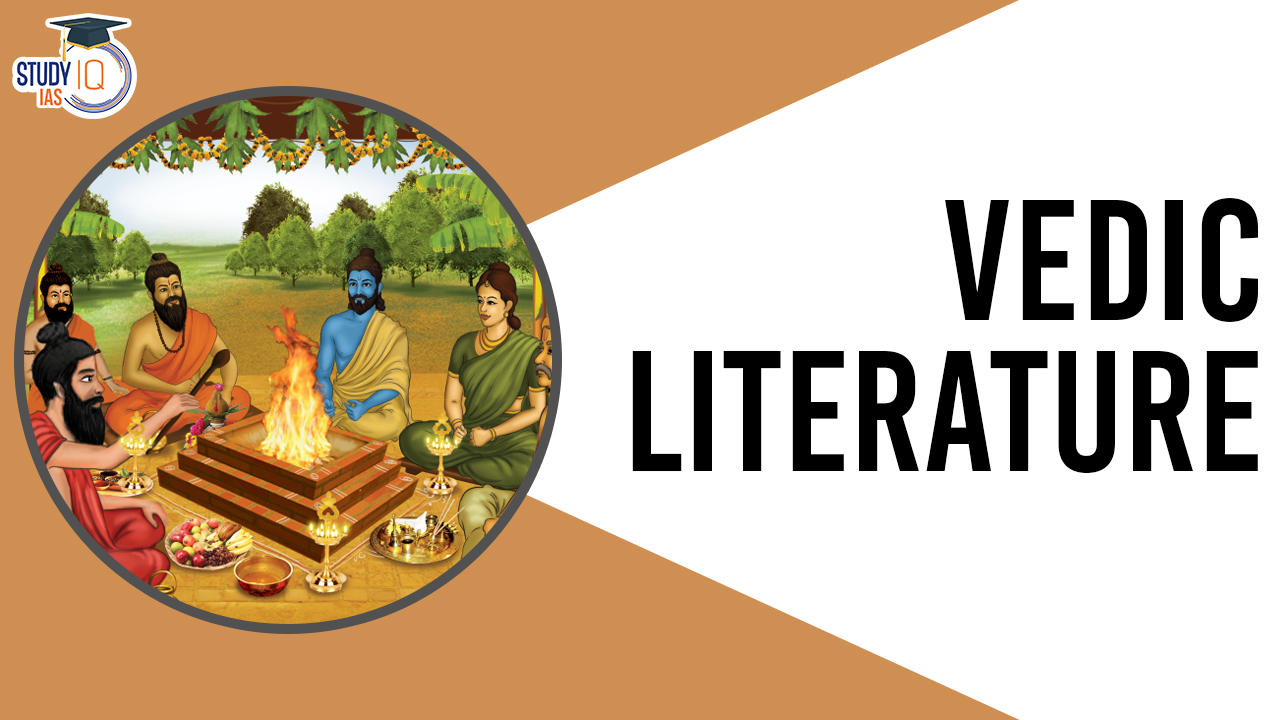
Table of Contents
Vedic Literature refers to the ancient sacred texts that form the foundation of Hinduism. These texts are among the oldest religious scriptures in the world and are considered the authoritative source of knowledge in various fields, including philosophy, theology, science, and ritual. The term “Vedic” is derived from the Sanskrit word “Veda,” which means knowledge or wisdom. The Vedic Literature is classified into four main categories: Samhitas, Brahmanas, Aranyakas, and Upanishads. Each category serves a specific purpose and contributes to the comprehensive understanding of Vedic philosophy and spirituality.
We’re now on WhatsApp . Click to Join
What is Vedic Literature?
The ancient and sacred texts of Hinduism were penned in the initial era’s Sanskrit, encompassing the Samhitas, Brahmanas, Aranyakas, and Upanishads in traditional belief. These Vedas stand as a testament to India’s profound cultural and religious traditions, encapsulating the essence of the nation’s heritage.
Their significance lies in more than just language; it extends to the richness of expression, understanding, and profound insights they offer. The Vedic literature serves as a repository of detailed information, providing insights into the socio-cultural origins of ancient India, the prevailing way of life, intricate rituals and ceremonies, societal norms, and the profound teachings of ancient Indian wisdom. This literary heritage not only reflects the cultural exuberance of the country but also serves as a timeless source for understanding the roots and evolution of Indian civilization.
Types of Vedic Literature
Vedic literature is broadly categorized into two main types: Shruti literature and Smriti literature, constituting the oldest Hindu writings and the earliest Sanskrit literature. The Vedas, regarded as the foundational scriptures, have been transmitted across generations through oral tradition. Let’s delve into each category in more detail:
Shruti Vedic Literature
Shruti literature comprises writings that hold fundamental significance in Hinduism, recognized for their profound insights and considered as repositories of indisputable truths. This category includes:
- Vedas: The core and oldest texts, the Vedas are divided into four parts – Rigveda, Samaveda, Yajurveda, and Atharvaveda. Each Veda consists of Samhitas (hymns), Brahmanas (rituals and ceremonies), Aranyakas (forest texts), and Upanishads (philosophical teachings).
| 1700 BC | Oldest and most significant Veda. – Contains 1028 hymns in ten books (mandalas) dedicated to various gods, including Indra, Agni, Vishnu, Rudra, Varuna, and other early Vedic deities. – Includes the renowned Gayatri mantra and the Purusha Shukta prayer, narrating the story of Primal Man. | ||
| 1000 and 800 BCE | Considered the ritual book. – Written approximately one or two centuries after the Rig Veda. – Signifies sacrifice (Yajur). – Divided into two parts: the older “black”/”dark” (Krishna Yajur Veda) section and the more current “white”/”bright” (Shukla Yajur Veda) section. – Functions as a priestly manual for yajnas (sacrifices). | ||
| 200 or 1000 BCE | Comprised of chants and melodies used in worship and yajna rituals. – Specifically created for ritualistic contexts, with words recited during soma sacrifice rituals. – Shortest among the four Vedas. – Connected to the Rig Veda. | ||
| 1000-800 BCE | Often referred to as the Veda of magic formulas. – Contains hymns, mantras, and incantations that fall outside the purview of yajna (sacrifices). |
- Brahmanas: These texts provide detailed explanations and instructions for the rituals and ceremonies mentioned in the Vedas. They offer a deeper understanding of the symbolic significance behind the rituals.
- Aranyakas: Bridging the gap between the ritualistic Brahmanas and the philosophical Upanishads, Aranyakas are associated with hermits and ascetics dwelling in the forest, focusing on contemplative practices.
- Upanishads: Representing the culmination of Vedic thought, Upanishads explore profound philosophical concepts, such as the nature of reality (Brahman) and the self (Atman). They encourage introspection and meditation for spiritual realization.
Check Here: Rig Vedic Period
Smriti Vedic Literature
In contrast, Smriti literature refers to works composed after the Vedic period and is often considered as remembered or traditional literature. This category includes:
- Puranas: These are vast compilations of myths, legends, and genealogies of gods, goddesses, and heroes. Puranas serve to disseminate religious and moral teachings in a narrative form.
- Upangas: Supplementary limbs of the Vedas, the Upangas cover various subjects, including grammar, metrics, astronomy, and law.
- Tantras: Focused on rituals, meditation, and worship, Tantras provide instructions for various spiritual practices.
- Upveda: Comprising four disciplines associated with each Veda – Ayurveda (related to medicine), Dhanurveda (archery and war), Gandharvaveda (music and performing arts), and Sthapatyaveda (architecture).
- Itihasa: Epic narratives, including the Ramayana and Mahabharata, which offer moral and philosophical teachings through captivating stories.
Check Here: Later Vedic Period
Vedic Literature – Vedas
The Vedas, foundational texts of Hinduism, are classified into four types:
- Rig Veda: The oldest and most significant Veda, consisting of hymns dedicated to various deities. Notable for its portrayal of early Vedic gods and includes the famous Gayatri mantra and Purusha Shukta.
- Sama Veda: Comprised of chants and melodies used during worship and rituals. Linked to the Rig Veda, it is the shortest of the four Vedas.
- Yajur Veda: Known as the ritual book, it provides guidelines for sacrificial ceremonies. It is divided into the Krishna Yajur Veda and Shukla Yajur Veda.
- Atharvaveda: Often referred to as the Veda of magic formulas, it contains hymns and incantations addressing various aspects of life outside the scope of traditional sacrifices.
Check here: Difference Between Early and Later Vedic Periods
Vedic Literature – Brahmanas
Brahmanas are prose texts embedded within each Veda, explaining the hymns and incorporating myths and legends. They serve as instructional material for Brahmins, detailing Vedic rituals. Brahmana literature also explores scientific knowledge, including observational astronomy and geometry related to altar construction. Some Brahmanas contain mystical and philosophical content, leading to the development of Aranyakas and Upanishads.
- Each Veda has its own Brahmanas, associated with specific Shakhas or Vedic schools.
- Fewer than twenty Brahmanas are extant today due to loss or destruction.
- The dating of Brahmanas is controversial, with the oldest dated around 900 BCE and the youngest around 700 BCE.

Vedic Literature – Aranyakas
Aranyakas, known as “Forest Books,” interpret sacrificial rituals in a symbolic and philosophical manner. They serve as a transition from external rituals to more internal, contemplative practices.
Vedic Literature – Upanishads
Upanishads are philosophical texts that explore profound ideas. Key points include:
- There are 108 Upanishads, with 13 considered major.
- Upanishads delve into the concepts of ‘Atman’ (individual self) and ‘Brahman’ (universal consciousness).
- They philosophically explore ideas related to sacrifice, the body, and the universe.
Vedic Literature – Vedangas
Vedangas, referred to as the limbs of the Veda, are six auxiliary disciplines essential for understanding and interpreting the Vedas. Mentioned in the Mundaka Upanishad, the Vedangas include:
- Siksha (pronunciation): Focuses on the correct pronunciation and phonetics of Vedic mantras.
- Kalpa (rituals): Deals with the procedures and rituals associated with Vedic ceremonies.
- Vyakarana (grammar): Concerned with the grammatical rules for understanding the Vedic texts.
- Nirukta (etymology): Involves the interpretation of Vedic words and their etymology.
- Chhanda (meter): Explores the meters and rhythms used in Vedic poetry.
- Jyotisa (astrophysics): Pertains to Vedic astronomy and timekeeping.
Vedic Literature – Shad-Darshana
The Shad-Darshana encompasses six schools of philosophical thought in India, each presenting distinct perspectives on life and existence. These are:
- Uttara Mimamsa: Concerned with the interpretation of the latter part of the Vedas, specifically the Upanishads.
- Nyaya: Deals with logic and reasoning.
- Vaisheshika: Explores atomic theory and metaphysics.
- Sankhya: Focuses on enumeration and the concept of dualism.
- Yoga: Explores the practice of spiritual discipline and meditation.
- Purva Mimamsa: Concerned with the interpretation of the earlier part of the Vedas, particularly the rituals and ceremonies.
These philosophical texts are written in a concise, direct, and aphoristic (Sutra) style, aiming to spread the values of righteous living.
Puranas are sacred texts providing a wealth of information on creation, ancestral lineage, moral guidelines, various worlds, and myths. While considered newer than the Vedas, they discuss the “later deities” like Brahma, Vishnu, and Shiva. Some well-known Puranas include Devibhagavata, Bhagavata, and Vishnu-Puranas.
Itihasas, such as the Ramayana and Mahabharata, are epic narratives. The Ramayana, authored by Maharishi Valmiki, consists of 24,000 verses, while the Mahabharata, composed by Maharishi Vyas, contains 100,000 verses.
Tantras encompass three main categories: Shaiva, Shakta, and Vaishnava. Tantric Literature, not consistently coherent, is primarily concerned with theistic worship and can include Agamas, Nigamas, and Samhitas. Saiva Tantras are often referred to as Agamas, Vaisnava Tantras as Samhitas, and Sakta Tantras as Tantras.
Agamas are instructional guides for deity worship, including Tantras, Mantras, and Yantras. They provide guidance on how to worship deities outside the body, such as in idols and temples, emphasizing four attributes: Jnana (Knowledge), Yoga (Concentration), Kriya (Esoteric Ritual), and Charya (Exoteric Worship).
Upavedas encompass four traditional branches of applied knowledge:
- Dhanurveda (art of warfare): Deals with military strategy and tactics.
- Gandharvaveda (music): Explores musical theory and practice.
- Silpaveda (art and architecture): Concerned with artistic principles and architectural design.
- Ayurveda (medicine): Focuses on traditional medical knowledge and practices.
Importance of Vedic Literature
- Spiritual Wisdom: Vedas, especially Upanishads, contain profound philosophical insights and spiritual teachings.
- Religious Guidance: Vedic literature provides detailed instructions for Hindu rituals, ceremonies, and sacrifices.
- Moral Lessons: Puranas and Itihasas embed moral and ethical teachings in mythological narratives.
- Historical Record: Offers glimpses into the socio-cultural aspects and lifestyle of ancient India, aiding in historical reconstruction.
- Linguistic Foundations: Vedangas, particularly Vyakarana, contribute to Sanskrit linguistics and grammar development.
- Astrological and Scientific Insights: Jyotisa in Vedic literature provides ancient Indian astronomy and scientific knowledge.
- Cultural Identity: Shapes the cultural identity of India and contributes to a shared heritage among its people.
- Basis for Later Texts: Many later Hindu scriptures draw inspiration and references from Vedic literature.
- Unity in Diversity: Serves as a common thread uniting followers across diverse Hindu sects and traditions.
Vedic Literature UPSC
Vedic literature, foundational to Hinduism, is a rich tapestry encompassing the Vedas, Upanishads, Brahmanas, and more. The Rig Veda, Sama Veda, Yajur Veda, and Atharvaveda constitute the core Vedas. They offer spiritual wisdom, ritual guidance, and moral lessons. Vedangas provide linguistic and grammatical foundations, while Puranas contribute historical and cultural insights. The Itihasas, including Ramayana and Mahabharata, narrate epic stories. The importance of Vedic literature lies in shaping Hindu philosophy, providing historical records, and influencing cultural identity, making it a pivotal topic in the UPSC examination for its multifaceted impact on India’s heritage.
Sharing is caring!
Vedic Literature FAQs
Vedic literature refers to the ancient sacred texts of Hinduism, including the Vedas, Upanishads, Brahmanas, and related texts.
How many Vedas are there?
There are four Vedas: Rig Veda, Sama Veda, Yajur Veda, and Atharvaveda.
What is the significance of the Rig Veda?
Rig Veda is the oldest and most significant Veda, containing hymns dedicated to various deities and foundational texts of Hinduism.
What do Vedangas focus on?
Vedangas are auxiliary disciplines focusing on pronunciation, rituals, grammar, etymology, meter, and astrophysics.
Greetings! I'm Piyush, a content writer at StudyIQ. I specialize in creating enlightening content focused on UPSC and State PSC exams. Let's embark on a journey of discovery, where we unravel the intricacies of these exams and transform aspirations into triumphant achievements together!
- art and culture
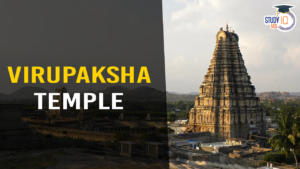
Leave a comment
Your email address will not be published. Required fields are marked *
Save my name, email, and website in this browser for the next time I comment.

- UPSC Online Coaching
- UPSC Exam 2024
- UPSC Syllabus 2024
- UPSC Prelims Syllabus 2024
- UPSC Mains Syllabus 2024
- UPSC Exam Pattern 2024
- UPSC Age Limit 2024
- UPSC Calendar 2024
- UPSC Syllabus in Hindi
- UPSC Full Form

Recent Posts
- UPPSC Exam 2024
- UPPSC Calendar
- UPPSC Syllabus 2024
- UPPSC Exam Pattern 2024
- UPPSC Application Form 2024
- UPPSC Eligibility Criteria 2024
- UPPSC Admit card 2024
- UPPSC Salary And Posts
- UPPSC Cut Off
- UPPSC Previous Year Paper
BPSC Exam 2024
- BPSC 70th Notification
- BPSC 69th Exam Analysis
- BPSC Admit Card
- BPSC Syllabus
- BPSC Exam Pattern
- BPSC Cut Off
- BPSC Question Papers
IB ACIO Exam
- IB ACIO Salary
- IB ACIO Syllabus
CSIR SO ASO Exam
- CSIR SO ASO Exam 2024
- CSIR SO ASO Result 2024
- CSIR SO ASO Exam Date
- CSIR SO ASO Question Paper
- CSIR SO ASO Answer key 2024
- CSIR SO ASO Exam Date 2024
- CSIR SO ASO Syllabus 2024
Study Material Categories
- Daily The Hindu Analysis
- Daily Practice Quiz for Prelims
- Daily Answer Writing
- Daily Current Affairs
- Indian Polity
- Environment and Ecology
- Art and Culture
- General Knowledge
- Biographies
IMPORTANT EXAMS

- Terms & Conditions
- Return & Refund Policy
- Privacy Policy
- IAS Preparation
- Topic of the Day
- Vedic Literature
Vedic Literature - Ancient History [UPSC GS-I Notes]
Having the status of ‘Shruti’ text (Meaning – Which has been heard), Vedas embody self-existent truth that is thought to be realized by the seers of Hindu tradition, in state of meditation. ‘Smriti’ texts (Meaning- Remembered) include Vedanga, Puranas, Epics, Dharmashashtra, and Nitishastra. This article will provide you relevant facts about Vedic Literature for the IAS Exam (Prelims, Mains – GS I).
Aspirants can read below-mentioned relevant articles of Ancient History for UPSC preparation:
Vedic Literature – What are Vedas?
The Vedas are the large bodies of religious text that is composed of Vedic Sanskrit and originated in ancient India. They form the oldest scriptures of Hinduism and the oldest layer of Sanskrit literature. The Vedas are said to have passed on through verbal transmission from one generation to the next. Therefore, they are also known as Shruti. The Vedic literature consists of four Vedas, namely: Rig Veda , Sama Veda, Yajur Veda, and Atharva Veda. The mantra text of each of the Vedas is called Samhita.
Types of Vedic Literature
There are broadly two types of Vedic literature:
- Shruti Literature – The word ‘Shruti’ from the term ‘Shruti Literature’ means ‘to hear’ and describes the sacred texts which comprise of Vedas, Brahmanas, Aranyakas, & Upanishads. Shruti Literature is canonical, consisting of revelation and unquestionable truth, and is considered eternal.
- Smriti Literature – Whereas, the word ‘Smiriti’ literally means to be remembered and which is supplementary and may change over time. Smriti Literature is the entire body of the post-Vedic Classical Sanskrit literature and consists of Vedanga, Shad darsana, Puranas, Itihasa, Upveda, Tantras, Agamas, Upangas.
The Vedic literature can be classified into the following categories:
- The four Vedas i.e. the Rig, Sama, Yajur, and Atharva, and their Samhitas. (Learn the difference between Vedas and Puranas in the linked article.)
- The Brahmanas
- The Aranyakas
- The Upanishads
Aspirants should know the difference between Vedas and Upanishads mentioned in the linked article.)
Vedic Literature – Vedas
There are four types of Vedas:
- Atharvaveda
Vedic Literature – Brahamanas
They are the prose texts that explain the hymns in the Vedas and are also the classification of Sanskrit texts that are embedded within each Veda, incorporating myths and legends to explain and instruct Brahmins on the performance of Vedic rituals. In addition to explaining the symbolism and meaning of the Samhitas, Brahmana literature also expounds scientific knowledge of the Vedic Period, including observational astronomy and, particularly in relation to altar construction, geometry. Divergent in nature, some Brahmanas also contain mystical and philosophical material that constitutes Aranyakas and Upanishads.
Each Veda has one or more of its own Brahmanas, and each Brahmana is generally associated with a particular Shakha or Vedic school. Less than twenty Brahmanas are currently extant, as most have been lost or destroyed. Dating of the final codification of the Brahmanas and associated Vedic texts is controversial, as they were likely recorded after several centuries of oral transmission. The oldest Brahmana is dated to about 900 BCE, while the youngest is dated to around 700 BCE.
Vedic Literature – Aranyakas
A few important points about Aranyakas are mentioned below:
- These are called Forest Books
- Sacrificial rituals are interpreted by Aranyakas in a symbolic and philosophical way.
Some more related links from ancient Indian history context are mentioned below:
- Poets in Ancient India
- Important Terms in Ancient Indian History
- Important Kingdoms and Dynasties of Ancient India
Vedic Literature – Upanishads
A few important points about Upanishads are mentioned below:
- There are 108 Upanishads
- Out of 108 Upanishads, 13 are considered the major ones.
- The concepts of ‘Atman’ and ‘Brahman’ are majorly explained by Upanishads
Vedic Literature is an important topic for the Civil Service Exam. Candidates preparing for UPSC 2024 are advised to go through the other History topics as several questions are asked from this section for IAS Prelims and Mains.
After reading about Vedic Literature, one may also read about Philosophy in Medieval India from the linked article.
Aspirants can go through other NCERT notes on Ancient India for UPSC .
Vedic Literature – UPSC Notes:- Download PDF Here
Related links:
| IAS General Studies Notes Links | |
Leave a Comment Cancel reply
Your Mobile number and Email id will not be published. Required fields are marked *
Request OTP on Voice Call
Post My Comment
IAS 2024 - Your dream can come true!
Download the ultimate guide to upsc cse preparation, register with byju's & download free pdfs, register with byju's & watch live videos.
PLEDGE PAYMENTS
Select your residency.
For all Indian residents/citizens - please donate via this page
INTERNATIONAL - ALL OTHERS
For everyone else please use this page
- Architecture Dept. Reports
- PMC Reports
- TOVP in the Press
- Founder’s Vision
- Jananivasa Prabhu Speaks About the TOVP
- A Landmark Spiritual Project of Universal Significance
- Revealing The Heart of ISKCON
- Prabhupada TOVP and Mayapur Quotes
- Vedic Cosmology
- Vedic Cosmology Videos
- Vedic Wisdom Videos
- Intelligent Design Videos
- Vedic Science Essays
- Vedic Science Channel
- Shabda Media
- Cosmic Chandelier
- Vedic Science Center
- Planetarium Wing
- The Bhaktivedanta Institute
- Bhaktivedanta Institute for Higher Studies
- Bhaktivedanta Vidyapitha Research Center
- Institute for Science and Spirituality
- Book Marketplace
- TOVP Photos
- TOVP Artwork Collection
- Visions of the TOVP
- Archival Photos
- TOVP Videos
- Vedic Science Channel Videos
- TOVP Talks – Vision of the Parampara
- Archival Videos
- Flipbook Collection
- Chairman’s Message
- Mayapur Vedic City
- TOVP Foundation
- Privacy Policy
- Terms and Conditions
- Construction Department
- Fundraising Department
- Planetarium Department
- Our Worldwide Team
- Fundraising Director’s Message
- Donation Details / Pledge Payments / Contacts
- Russian Donations Details
- Bank Transfer Details
- Donate in Crypto Currency
- Planned Giving (U.S. only) New
- Donor Account Dashboard
- Donation Hotlines
- Save Dharma Campaign
- Our Trustees
- 31 Dresses Campaign Donors
- Diamonds of the Dome Donors
- Doors of The Dhama Donors
- Rooms of Worship Donors
- Radha Madhava Steps Donors
- Pancatattva Steps Donors
- Guru Parampara Steps Donors
- Atma-nivedanam Pillar Donors
- Smaranam Pillar Donors
- Kirtanam Pillar Donors
- Sravanam Pillar Donors
- Maha Nrsimha Yajna Yajamans Donors
- Sadhu Sanga Seva Award – Gold Donors
- Prabhupada Seva Award (Bronze) Donors
- Harinam Medallion Donors
- Bhagavatam Medallion Donors
- Archa Vigraha Medallion Donors
- Radharani Coin Donors
- Caitanya Coin Donors
- Nityananda Coin Donors
- Advaita Coin Donors
- Gadadhar Coin Donors
- Srivas Coin Donors
- Radha Madhava Brick Donors
- Mahaprabhu Brick Donors
- Guruparampara Brick Donors
- Nrisimha Brick Donors
- General Donors
- Quarterly Report Apr – Jun 2021
- Quarterly Report Jul – Sept 2021
- Educational
TOVP Vedic Science Essays: The Universe of the Vedas
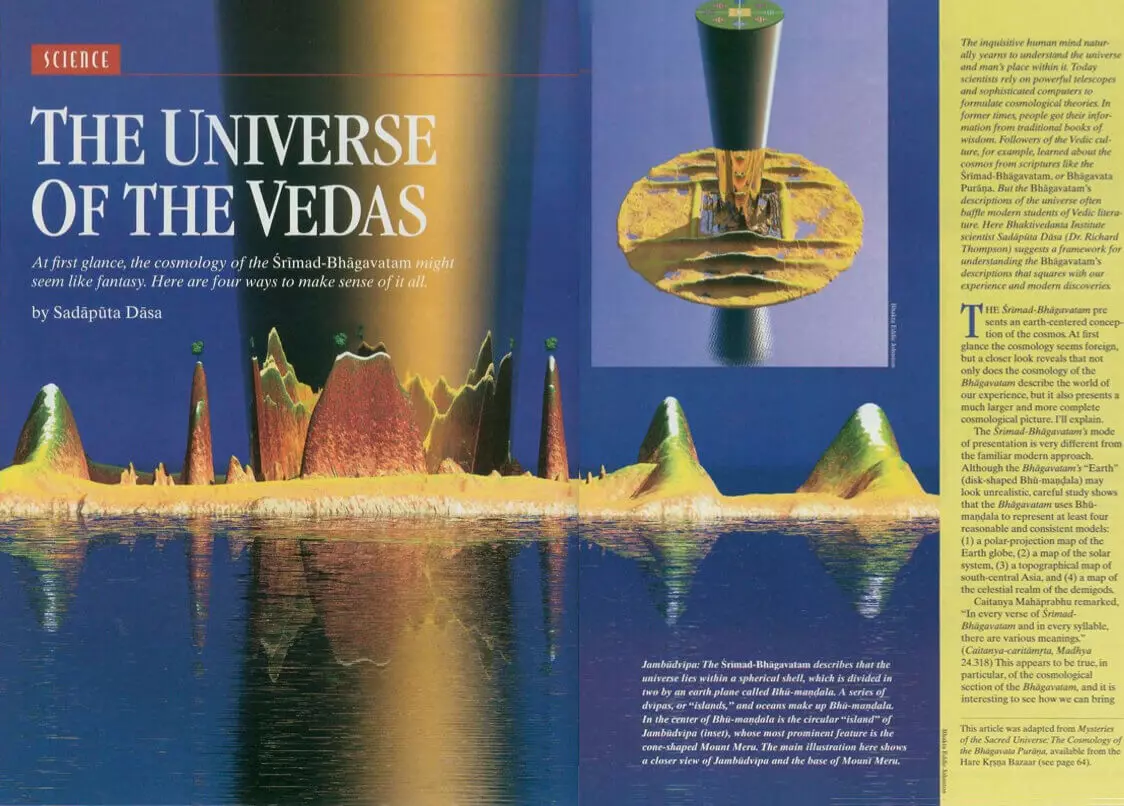
The Universe of the Vedas By Dr. Richard L. Thompson (Sadaputa Dasa)
The Srimad-Bhagavatam presents an earth-centered conception of the cosmos. At first glance the cosmology seems foreign, but a closer look reveals that not only does the cosmology of the Bhagavatam describe the world of our experience, but it also presents a much larger and more complete cosmological picture.
To read the full essay: https://richardlthompson.com/article/universe-vedas
You can purchase books by Dr. Thompson HERE .
Go to Vedic Science Essays page to read more articles.

JOIN THE TOVP MISSION 26 MARATHON
Help open the tovp by 2026 and make srila prabhupada's dream a reality..

- 0260 - 2373346
- 0260 - 2375888
- [email protected]

- Vedic Research Institute
- Sanskrit Education
- Kamadhenu Gaushala
- Kamadhenu Panchagavya
- Yoga and Health Centre
- Commentaries on Vedas
- Main Objective and Activities
- Memorabilia
- Brahmarshi Padmabhushan Pandit Shripad Damodar Satavlekar
Swadhyay Mandal Vedic Research Institute. Founder: Brahamarshi, Padmabhushan, Pandit Shripad Damodar Satavlekar.(1867-1968) Year of Establishment: 1918
Commentaries on Vedas Vedas are acknowledged as the most ancient literature of the world. The exposition of the meaning of Vedas traditionally remained oral only till the advent of writing and printing. Later on these traditional expositions were reduced to writing and they were known as commentaries. With the passage of time there is an inevitable change in the use of language and the meaning of words in some cases. To interpret the Vedas according to current dictionary meanings of words can therefore be misleading . Meanings have therefore to be taken as they are traditionally handed down. Even then human error may tend to distort the meanings. An elaborate technical system was therefore introduced in the ancient past to aid correct interpretation. It is known as Vedangas. It is traditionally incumbent on any commentator to interpret the Vedas consistent with this system only.
In addition to the aid provided by Vedangas, one must follow the traditional Meemansa method while interpreting the Vedas. Meemamsa method is primarily used in harmonising , or reconciling the apparent inconsistencies found in Vedic texts or other scriptures. It is considered inappropriate to use the modern Historical method to interpret the Vedas .It can and often does distort the original and traditionally handed down meaning .All traditional Commentators have scrupulously followed these conditions in writing their commentaries.
Compared with the Vedas, the Sutra literature is of recent origin. Sutras are aphorisms or short or concise technical sentences convenient for memorising .Commentaries on sutras are absolutely necessary to understand the sutras as they carry considerable meaning in a few words.
Unfortunately ancient commentaries on Vedas are not now available and those available are of relatively recent origin. The known commentators on Vedas are Skandaswamy, Anandtirth, Narayancharya , Udgithacharya,Hastamalak,Venkatmadhav,Laxmanacharya,Dhanushkayajwa ,Atmanandtirth, Sayanacharya,Ravana, Mudgalacharya, Devaswamy, Chaturvedaswamy, Dayanandswamy, Bhattaswamy,Bhattabhaskar, Guhadeva,Durgacharya,Ubbat and Mahidhar.However, barring Sayanacharya, Ubbat and to some extent Dayanandswamy ,the commentaries of all other commentators are incomplete. The commentaries of Sayanacharya and Ubbat are greatly recognized and considered as authoritative. Even so, the meaning of many words and mantras(stanzas , hymns) have defied all the commentaries till date.
All these commentaries are in sanskrit language. Pandit Satavlekar’s Commentaries Pandit Satavlekar was the first to write complete commentaries on Rigveda, Madhyandin Vajsaneyi Shukla Yajurveda and Atharvaveda and provide complete translation of Samaveda. The distinguishing feature of his works is that they are all in Hindi language, It was only appropriate , that Hindi being our National language ,Panditji gave priority to Hindi while writing his commentaries, Panditji has thus rendered a great service to the large Hindi knowing public in India and abroad. Some of these commentaries are available in Marathi and Gujrati as well.
Panditji was not a mere academician. Born in orthodox Vedic family he was steeped in Vedic tradition. He had deeply studied the Vedas for decades before he thought of writing commentaries on them. He had also published the correct versions of the Vedas earlier and they were accepted and followed all over India. He was neither an iconoclast nor a blind follower of earlier commentators Rather, he was an independent thinker. That is why in spite of his long association with Arya Samaj he had significant differences with them. He was also strongly opposed to the offerings of animals as oblations in the ritual Vedic sacrifices( Yajnas) as they were not sanctioned by the Vedas In fact there is a positive injunction not to kill animals in Rigveda, Yajurveda, Atharvaveda, Shatapatha,Brahman and Mahabharata Shanti Parva. Panditji valued all traditions consistent with the Vedas and he himself lived accordingly. Pandit Satavlekar’s views on Vedas According to Panditji Vedas are of human origin and Rishis ( sages) were human beings only albeit highly accomplished and elevated. The knowledge contained in the Vedas is divine knowledge only. That knowledge was articulated by Rishis . Divinity itself spoke through the Rishis. It was and is necessary for all the commentators on Vedas to pay special attention to the national, social, and political perspectives ; understanding of human life, impulses and conduct; spiritual and philosophical contemplation and social duties and obligations vis-a-vis the Vedas. Consider the Vedas on the basis of Vedas only, understand Vedas per se and then only proceed to either translate them or write commentaries on them. This was Panditji’s view .
The culmination of all scriptures including the Vedas is in the overall human progress and achievement. Spirituality per se tends to distort human life .Overall success and achievement here must precede liberation hereafter.Any deliberation on scriptures is possible only in a nation fully protected with arms.Those who merely recite the Vedas are not thinkers at all. They never think on the meaning of Vedas. Those who literally translate or comment on Vedas without any consideration of the national, social, and other aspects of Vedas, end in ritualism. Those who obstinately stick to the meaning given by their tradition refuse to consider any other view or meaning. Panditji belonged to none of these categories. He deeply studied all the commentators and their commentaries but never blindly followed them. He engaged himself in thinking, contemplation and writing and always kept an open mind. English Translation of Panditji’s Commentaries There has been a persistent demand for publishing English translation of Panditji’s Hindi commentaries on the three Vedas and translation of Samaveda .It has not, however been possible to comply with this demand owing to the paucity of resources and competent manpower. Even so, Swadhyay Mandal has under active consideration, a proposal to undertake the English translation. In the meanwhile we plan to provide English translation of a few selected Suktas (hymns) and hope you will welcome it.
Sanskrit Books
Hindi Books
Marathi Books
Gujarati Books
English Books
© Copyright 2024 Swadhyay Mandal - Vedic Research Institute by Persistent Computer Services | All Rights Reserved.
Mobile menu

73 pages • 2 hours read
The Rig Veda: An Anthology
A modern alternative to SparkNotes and CliffsNotes, SuperSummary offers high-quality Study Guides with detailed chapter summaries and analysis of major themes, characters, and more.
Chapter Summaries & Analyses
Chapters 3-4
Chapters 9-10
Chapters 11-12
Key Figures
Symbols & Motifs
Important Quotes
Essay Topics
Discussion Questions
The Soma sacrifice is the most important ritual in the Rig Veda and the subject of hundreds of Vedic hymns. What images, metaphors, and similes describe the preparation of the sacred beverage, and how do they relate to each other? Describe the mythology of the god Soma as elaborated in the hymns of the text.
Describe the important elements of the sacrifice in Vedic religion. What roles do Agni and his priests play in the sacrifice? How does the Rig Veda depict the origins of the sacrifice?
The Rig Veda abounds in creation stories such as the Golden Embryo (10.121), Purusa, the Primordial Man (10.90), the All-Maker (10.81-2), and Indra’s killing of Vrtra and release of the waters (1.32). Some of these are closely related, sharing similar structures while differing in detail; others represent a very different view of the origins of the universe. Compare and contrast several of these creation myths, analyzing significant differences, such as whether the story reflects a monistic or dualistic viewpoint, and a personal or impersonal view of the Creator.

Don't Miss Out!
Access Study Guide Now
Related Titles
By these authors

Arabian Nights
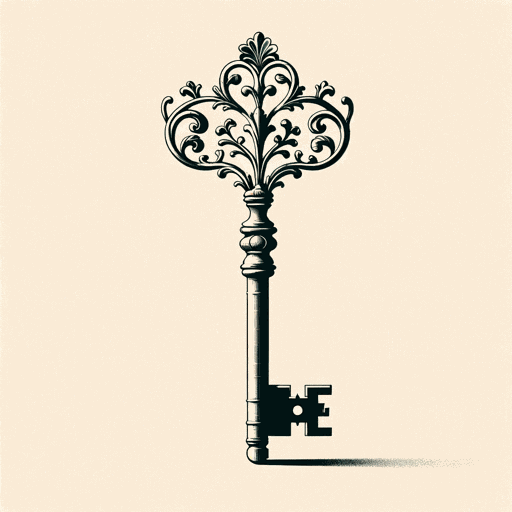
Arden of Faversham

A Woman in Berlin

Bible (New Testament): English Standard Version
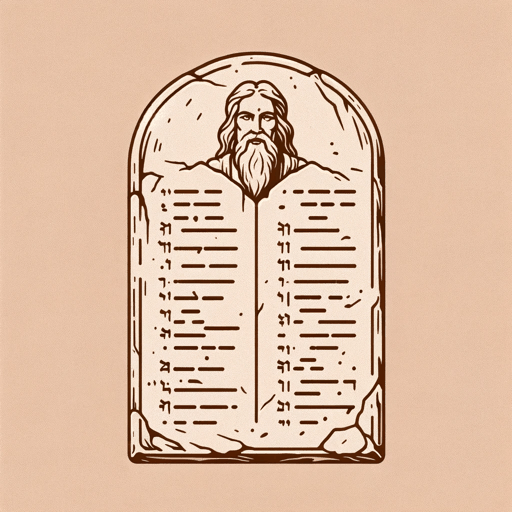
Bible: Old Testament: English Standard Version

Deuteronomy

Diary of an Oxygen Thief
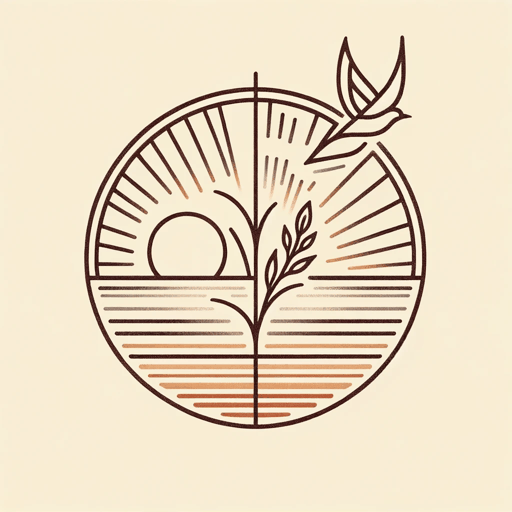
Do Not Stand at My Grave and Weep
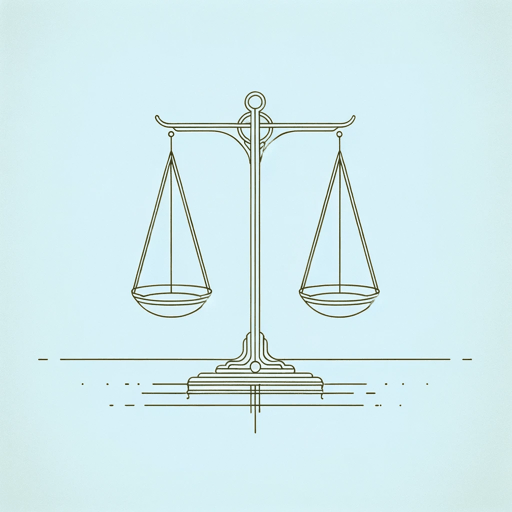
Hebrew Bible

Homeric Hymns
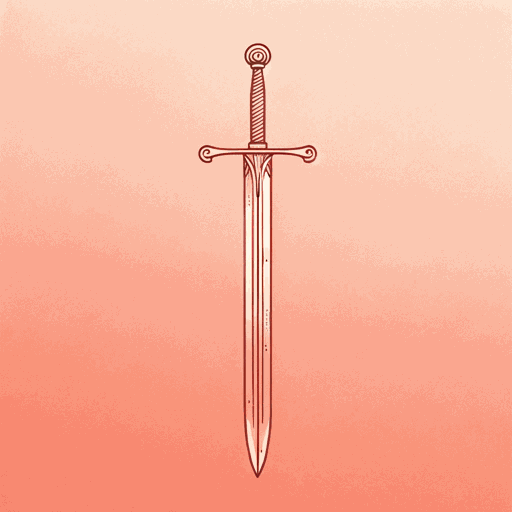
Laxdaela Saga

Lazarillo De Tormes

Mahabharata

Nibelungenlied

One Thousand and One Nights

Featured Collections
Religion & Spirituality
View Collection
Talk to our experts
1800-120-456-456
- India Essay

Essay on India
India is the largest democratic country. It is a big country divided into 29 states and 7 union territories. These states and union territories have been created so that the government can run the country more easily. India also has many different kinds of physical features in different parts of the country that are spread over its states and union territories. India is a very diverse country as well, which means that the people around the country are different in many ways. Even though India is such a diverse place, it is united as one country.
Political Divisions
India is the seventh-largest country and has the second-largest population in the world. Here is the map of India showing 29 states and 7 union territories. These political divisions are made so that the government can run the country more easily. Though we live in different states, everyone is an Indian first.
[Image will be uploaded soon]
Physical Features
The Indian subcontinent has many different physical features shared with its neighbours that are also in the subcontinent – Pakistan, Nepal, Bhutan and Bangladesh. The physical features of India form six different natural regions.
The Northern Mountains
The Northern Plains
The Great Indian Desert
The Southern Plateau
The Coastal Plains
The Island Regions
The Northern Mountains: These are the Himalayas, the highest mountain range in the world. They form a natural boundary between India and a large part of Asia. Two neighbouring countries, Nepal and Bhutan are situated in these mountains.
The Northern Plains: They are located to the south of the Himalayas. They extend into Pakistan in the west. Bangladesh is situated on the eastern part of the plains.
The Great Indian Desert: The western part of India is a desert with less rainfall. This desert is called the Thar Desert.
The Southern Plateau: This plateau region lies to the south of the Great Northern Plains and is called the Deccan Plateau. The Vindhya and Satpura ranges in the north, the Western Ghats and the Eastern Ghats surround the Deccan Plateau.
The Coastal Plains: The Eastern coastal plain lies between the Bay of Bengal and the Eastern Ghats. The western coastal plain lies between the Arabian Sea and the Western Ghats.
The Island Regions: The island regions of India are two archipelagos on either side of Peninsula India. The Lakshadweep Islands are in the Arabian Sea and the Andaman and Nicobar Islands are in the Bay of Bengal.
The Rivers of India
The Indian subcontinent has many rivers. Some important rivers are the Indus, Ganga, Yamuna, Brahmaputra, Sutlej, the Narmada and Tapi rivers.
These physical features and rivers link the people of India.
National Symbols
The National Flag of India is in the tricolour of deep saffron at the top, white in the middle and dark green at the bottom in equal proportions. The saffron stands for courage, sacrifice and the spirit of renunciation, the white for purity and the truth and the green for faith and fertility. In the centre of the white band, there is a wheel of law in the Sarnath Lion Capital.
The National Emblem of India is a replica of the Lion of Sarnath and symbolizes India’s reaffirmation of its ancient commitment to world peace and goodwill.
The National Anthem of India is Jana Gana Mana and the National song is Vande Mataram.
The National Animal of India is Tiger, which symbolizes grace, strength and power.
The National Bird of India is Peacock, which symbolizes beauty, majesty and pride.
The National Flower of India is Lotus, which symbolizes purity, wealth, richness, knowledge and serenity.
The National Tree of India is the Great Banyan Tree and because of its characteristics and longevity, the tree is considered immortal and sacred. It is an integral part of the myths and legends in India.
The National Fruit is Mango and it is the most cultivated fruit of the tropical world.
Indian food is diverse. The geography of a region influences the food that people eat. The staple food of people is what grows in their regions. In North India, the staple food is Wheat. In East and South India, the staple food is Rice. In West India, the staple food is Millet. Daals are eaten in almost the entire country and prepared in different ways.
Indians speak different languages. The Constitution of India mentions 22 languages. However, India has around 800 languages. Hindi is the official language of India.
India is a country of many different religions and each has different festivals. Some important festivals are Baisakhi, Diwali, Eid, Ganesh Chaturthi, Dussehra and Christmas.
Unity in Diversity
The people of India, their foods, festivals and languages – all these make India a very diverse country. However, there are also things that unite the people of India:
The National symbols like the Indian flag and the National Anthem.
The Constitution of India, which was written in the early years of our Independence. It unites the Indians because it has rules and laws that are the same for all people.
The Constitution says that all Indians are equal in the eyes of the law.
All Indians who are over the age of 18 and have registered as voters can vote in elections.

FAQs on India Essay
Q1. Describe the National Flag of India.
Ans. The National Flag of India is in the tricolour of deep saffron at the top, white in the middle and dark green at the bottom in equal proportions. The saffron stands for courage, sacrifice and the spirit of renunciation, the white, for purity and the truth and the green for faith and fertility. In the centre of the white band, there is a wheel of law in the Sarnath Lion Capital.
Q2. What is the population of India?
Ans. The population of India is 1 billion 325 million. India has the second-largest population in the world.
Q3. What are the important Festivals Celebrated in India?
Ans. Some of the important festivals celebrated in India are Diwali, Dussehra, Eid and Christmas.
Q4. Why is India called the largest Democratic Country?
Ans. India is the largest democratic country because the citizens of India have the right to elect their representatives who form and run the government.

COMMENTS
Vedas are the foremost sacred books of Hinduism. There are four Vedas and they claim to teach a man the highest truths that can lead him to God. The first three vedas are known as the Triple vedas. The Rig veda (veda of Hymns) consists of 1028 hymns (ten books) to gods like Indra and Agni. The Yajur veda (veda of liturgy) concerns the knowledge ...
The Vedas are considered the earliest literary record of Indo-Aryan civilization and the most sacred books of India. They are the original scriptures of Hindu teachings, containing spiritual knowledge encompassing all aspects of life.The philosophical maxims of Vedic literature have stood the test of time, and the Vedas form the highest religious authority for all aspects of Hinduism and are a ...
There are four types of Vedas - Rigveda, Samaveda, Yajurveda, and Atharvaveda. One of the best sources of Ancient Indian History is Vedic literature. Vedas have formed the Indian scripture. The ideas and practices of Vedic religion are codified by the Vedas and they also form the basis of classical Hinduism.
The Vedas are the main source of Hindu beliefs and practices. Their knowledge is considered the standard knowledge in Hinduism, which means any truth is valid in Hinduism only if it is affirmed by the Vedas. This is the tradition for the last 4000 years or even more. For Hindus the Vedas are inviolable, eternal, and revealed by God for the ...
About the Vedas, translations, Vedic literature, Vedic beliefs and practices, rituals and sacrifices, Vedic gods and goddesses, vedic tradition, history and philosophy, and related subjects. ... This is a complete English translation of the Atharvaveda. Veda Essays . The Vedas are difficult to understand since they contain a lot of symbolism ...
M.A., English Literature, University of North Bengal; Subhamoy Das is the co-author of "Applied Hinduism: Ancient Wisdom for Today's World." He has written several books about Hinduism for children and young adults. ... Hindu mythology mentions as many as 28 Vyasas before Maharshi Veda Vyasa was born at the end of Dvapara Yuga. Also known as ...
Essay On Veda Vyasa In English. Veda Vyasa is a sage who lived more than 3,000 years ago. He was the son of the sage Parashara who is believed to be the author of the first Purana, the Vishnu Purana. Another great sage Vasistha was the grandfather of Veda Vyasa, and his mother was Satyavathi. Veda Vyas was named as Krishna Dvaipayana, as he was ...
Defining The Vedas and Upanishads. Before exploring other aspects of the Vedas and Upanishads, it is necessary to define both terms. The Vedas are religious texts that inform the Hindu religion, which is also called Sanatan Dharma, indicating "Eternal Path". The term 'Veda' is used to refer to knowledge since the Vedas are thought to have fundamental knowledge that relates to response ...
Questions, conjectures and debates go hand in hand with the Vedas, the sacred keystone texts of Hinduism. Now, noted historian Roshen Dalal sifts through centuries of information and research to present, in a straightforward and succinct manner, an account of the Vedas that is authoritative yet accessible, thus appealing to both scholars and ...
There is a new English translation of the R̥ gveda by Stephanie Jamison and Joel Brereton (2014), and we now have two volumes of a four-volume German translation under the editorship of Michael Witzel and Toshifumi Gotō (2007, 2013). ... Two of these papers study the relation of the Veda to Buddhism. Karen Muldoon-Hules discusses the ...
Four Vedas - English Translation. Four Vedas - English Translation. Rahul A. See Full PDF Download PDF. See Full PDF Download PDF. Related Papers. Itihāsa of Vṛtra & Dadhyañc in Rigveda brahman madhu vidyā metalwork King Soma metaphors. Srini Kalyanaraman. Materialistic interpretation of मधु-विद्या Yajña is issuance ...
Shruti Vedic Literature. Shruti literature comprises writings that hold fundamental significance in Hinduism, recognized for their profound insights and considered as repositories of indisputable truths. This category includes: Vedas: The core and oldest texts, the Vedas are divided into four parts - Rigveda, Samaveda, Yajurveda, and Atharvaveda.
The Vedas are a major textual foundation of Hinduism, yet much of their content remains obscure and difficult to access. A discussion of recent literature on the Vedas provides the scholar with a clear conception of the nature of Vedic textual materials, the world views implied by Vedic texts and the nature of Vedic ritual, the central element of Vedic religion.
Smriti Literature is the entire body of the post-Vedic Classical Sanskrit literature and consists of Vedanga, Shad darsana, Puranas, Itihasa, Upveda, Tantras, Agamas, Upangas. The Vedic literature can be classified into the following categories: The four Vedas i.e. the Rig, Sama, Yajur, and Atharva, and their Samhitas.
The Universe of the Vedas By Dr. Richard L. Thompson (Sadaputa Dasa) The Srimad-Bhagavatam presents an earth-centered conception of the cosmos. At first glance the cosmology seems foreign, but a closer look reveals that not only does the cosmology of the Bhagavatam describe the world of our experience, but it also presents a much larger and ...
A New Approach to the Vedas: An Essay in Translation and Exegesis - Ebook written by Ananda Kentish Coomaraswamy. Read this book using Google Play Books app on your PC, android, iOS devices. Download for offline reading, highlight, bookmark or take notes while you read A New Approach to the Vedas: An Essay in Translation and Exegesis.
Vedas are acknowledged as the most ancient literature of the world. The exposition of the meaning of Vedas traditionally remained oral only till the advent of writing and printing. ... There has been a persistent demand for publishing English translation of Panditji's Hindi commentaries on the three Vedas and translation of Samaveda .It has ...
3. The Rig Veda abounds in creation stories such as the Golden Embryo (10.121), Purusa, the Primordial Man (10.90), the All-Maker (10.81-2), and Indra's killing of Vrtra and release of the waters (1.32). Some of these are closely related, sharing similar structures while differing in detail; others represent a very different view of the ...
The message of Maharshi Swami dayanand - Back to the Vedas Swami Dayanand was born on February 12, 1824 in Tankara in the western Indian state of Gujarat. At a time when Hinduism was divided between the various schools of philosophy and theology, Swami Dayanand went straight back to the Vedas as he considered them the most authoritative ...
Mail ID: [email protected]. Cell Phone : 984930174 1. Abstract. This paper aims to trace out the basic faith of Vedic knowledge as the fundamental base of. Hindu way of life. U sing the ...
The compass guiding this journey through the world's cultural landscapes is respect for the dignity of man everywhere. 9 4 IMAGINING THE BIRTH OF THE UNIVERSE The Vedas THE QUEST FOR AN INNER UNIVERSE by Rao Chelikani and Roseline de Laval 10 The Qur'an THE WORD OF GOD by Norreddm Mahammed 14 GUARANI GENESIS by Rubén Bareiro Saguier 18 OUT OF ...
#vedicliterature #vedas #essayinvedas #rigveda #samavedam #ancienthistory
Essay on India. India is the largest democratic country. It is a big country divided into 29 states and 7 union territories. These states and union territories have been created so that the government can run the country more easily. India also has many different kinds of physical features in different parts of the country that are spread over ...